MetLife (MET) 8-KResults of Operations and Financial Condition
Filed: 1 Jun 06, 12:00am
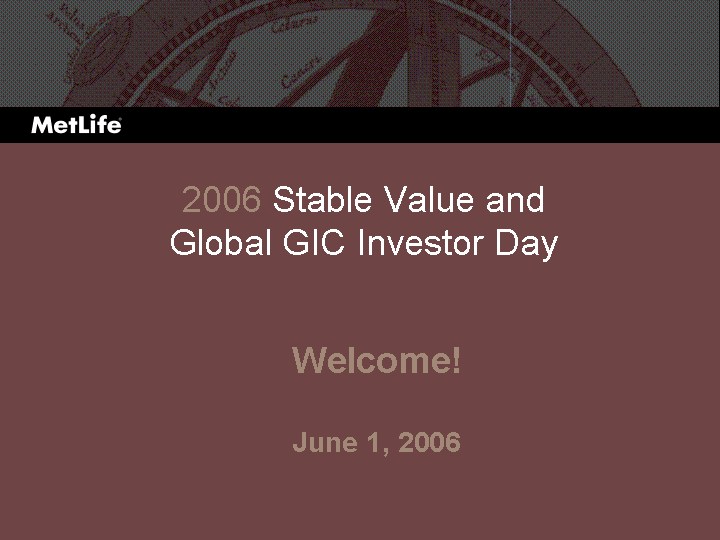
| 2006 Stable Value and Global GIC Investor Day Welcome! June 1, 2006 |
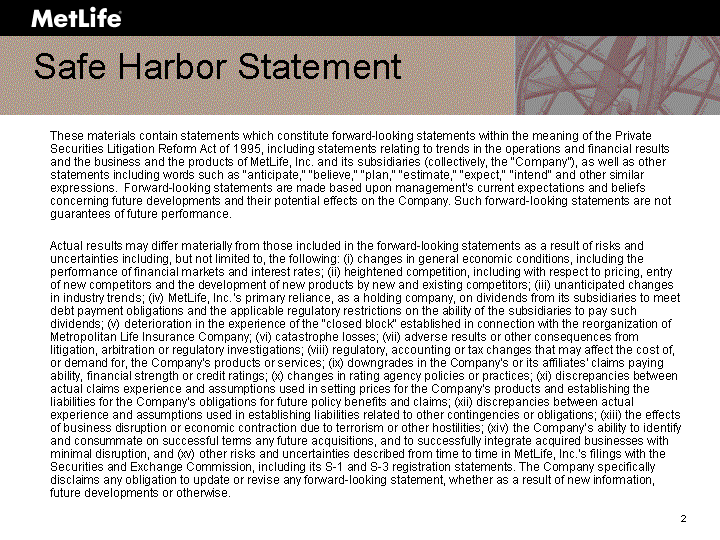
| Safe Harbor Statement These materials contain statements which constitute forward-looking statements within the meaning of the Private Securities Litigation Reform Act of 1995, including statements relating to trends in the operations and financial results and the business and the products of MetLife, Inc. and its subsidiaries (collectively, the "Company"), as well as other statements including words such as "anticipate," "believe," "plan," "estimate," "expect," "intend" and other similar expressions. Forward-looking statements are made based upon management's current expectations and beliefs concerning future developments and their potential effects on the Company. Such forward-looking statements are not guarantees of future performance. Actual results may differ materially from those included in the forward-looking statements as a result of risks and uncertainties including, but not limited to, the following: (i) changes in general economic conditions, including the performance of financial markets and interest rates; (ii) heightened competition, including with respect to pricing, entry of new competitors and the development of new products by new and existing competitors; (iii) unanticipated changes in industry trends; (iv) MetLife, Inc.'s primary reliance, as a holding company, on dividends from its subsidiaries to meet debt payment obligations and the applicable regulatory restrictions on the ability of the subsidiaries to pay such dividends; (v) deterioration in the experience of the "closed block" established in connection with the reorganization of Metropolitan Life Insurance Company; (vi) catastrophe losses; (vii) adverse results or other consequences from litigation, arbitration or regulatory investigations; (viii) regulatory, accounting or tax changes that may affect the cost of, or demand for, the Company's products or services; (ix) downgrades in the Company's or its affiliates' claims paying ability, financial strength or credit ratings; (x) changes in rating agency policies or practices; (xi) discrepancies between actual claims experience and assumptions used in setting prices for the Company's products and establishing the liabilities for the Company's obligations for future policy benefits and claims; (xii) discrepancies between actual experience and assumptions used in establishing liabilities related to other contingencies or obligations; (xiii) the effects of business disruption or economic contraction due to terrorism or other hostilities; (xiv) the Company's ability to identify and consummate on successful terms any future acquisitions, and to successfully integrate acquired businesses with minimal disruption, and (xv) other risks and uncertainties described from time to time in MetLife, Inc.'s filings with the Securities and Exchange Commission, including its S-1 and S-3 registration statements. The Company specifically disclaims any obligation to update or revise any forward-looking statement, whether as a result of new information, future developments or otherwise. |
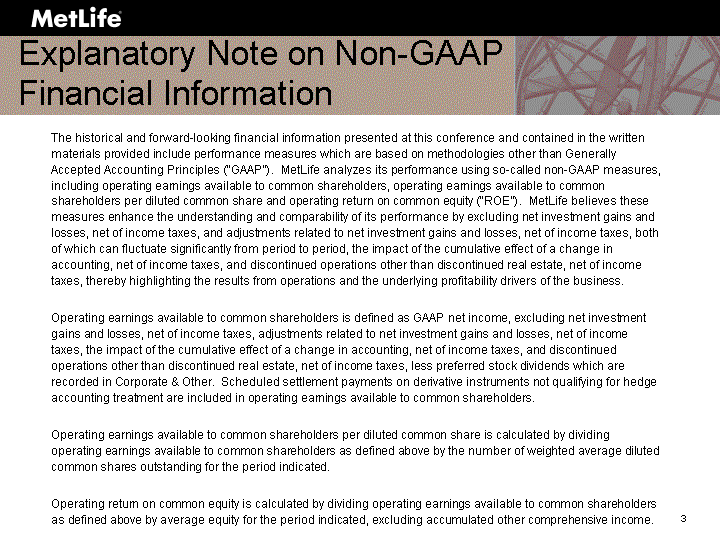
| Explanatory Note on Non-GAAP Financial Information The historical and forward-looking financial information presented at this conference and contained in the written materials provided include performance measures which are based on methodologies other than Generally Accepted Accounting Principles ("GAAP"). MetLife analyzes its performance using so-called non-GAAP measures, including operating earnings available to common shareholders, operating earnings available to common shareholders per diluted common share and operating return on common equity ("ROE"). MetLife believes these measures enhance the understanding and comparability of its performance by excluding net investment gains and losses, net of income taxes, and adjustments related to net investment gains and losses, net of income taxes, both of which can fluctuate significantly from period to period, the impact of the cumulative effect of a change in accounting, net of income taxes, and discontinued operations other than discontinued real estate, net of income taxes, thereby highlighting the results from operations and the underlying profitability drivers of the business. Operating earnings available to common shareholders is defined as GAAP net income, excluding net investment gains and losses, net of income taxes, adjustments related to net investment gains and losses, net of income taxes, the impact of the cumulative effect of a change in accounting, net of income taxes, and discontinued operations other than discontinued real estate, net of income taxes, less preferred stock dividends which are recorded in Corporate & Other. Scheduled settlement payments on derivative instruments not qualifying for hedge accounting treatment are included in operating earnings available to common shareholders. Operating earnings available to common shareholders per diluted common share is calculated by dividing operating earnings available to common shareholders as defined above by the number of weighted average diluted common shares outstanding for the period indicated. Operating return on common equity is calculated by dividing operating earnings available to common shareholders as defined above by average equity for the period indicated, excluding accumulated other comprehensive income. |
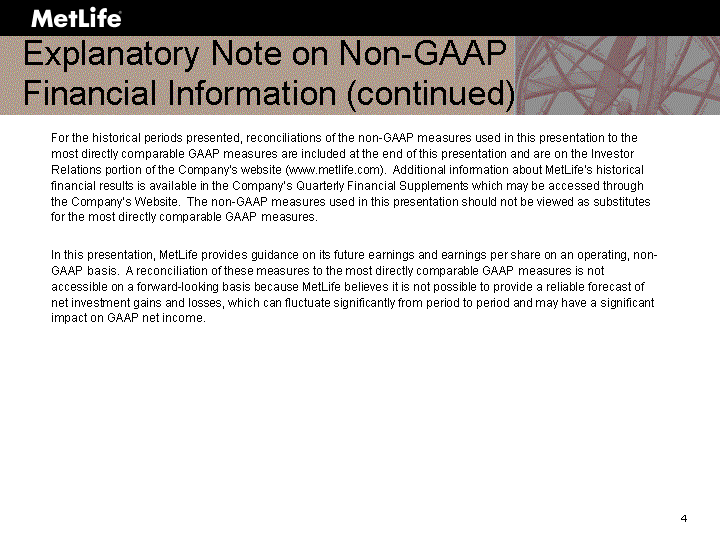
| Explanatory Note on Non-GAAP Financial Information (continued) For the historical periods presented, reconciliations of the non-GAAP measures used in this presentation to the most directly comparable GAAP measures are included at the end of this presentation and are on the Investor Relations portion of the Company's website (www.metlife.com). Additional information about MetLife's historical financial results is available in the Company's Quarterly Financial Supplements which may be accessed through the Company's Website. The non-GAAP measures used in this presentation should not be viewed as substitutes for the most directly comparable GAAP measures. In this presentation, MetLife provides guidance on its future earnings and earnings per share on an operating, non- GAAP basis. A reconciliation of these measures to the most directly comparable GAAP measures is not accessible on a forward-looking basis because MetLife believes it is not possible to provide a reliable forecast of net investment gains and losses, which can fluctuate significantly from period to period and may have a significant impact on GAAP net income. |
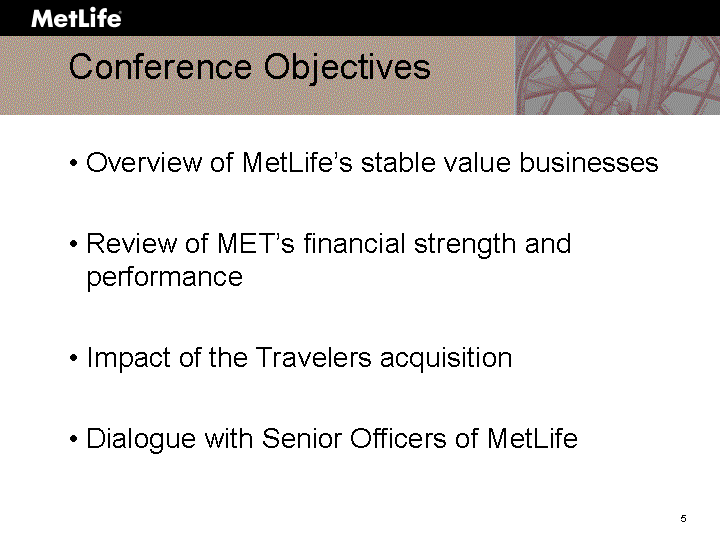
| Conference Objectives Overview of MetLife's stable value businesses Review of MET's financial strength and performance Impact of the Travelers acquisition Dialogue with Senior Officers of MetLife |
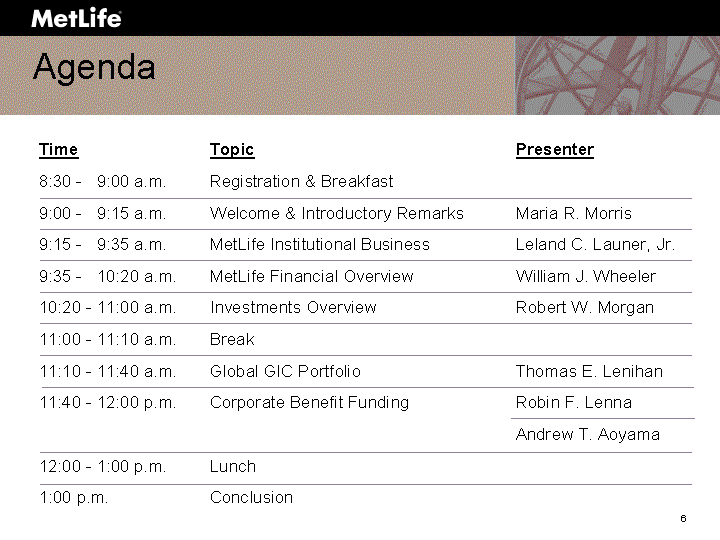
| Agenda Time Topic Presenter 8:30 - 9:00 a.m. Registration & Breakfast 9:00 - 9:15 a.m. Welcome & Introductory Remarks Maria R. Morris 9:15 - 9:35 a.m. MetLife Institutional Business Leland C. Launer, Jr. 9:35 - 10:20 a.m. MetLife Financial Overview William J. Wheeler 10:20 - 11:00 a.m. Investments Overview Robert W. Morgan 11:00 - 11:10 a.m. Break 11:10 - 11:40 a.m. Global GIC Portfolio Thomas E. Lenihan 11:40 - 12:00 p.m. Corporate Benefit Funding Robin F. Lenna Andrew T. Aoyama 12:00 - 1:00 p.m. Lunch 1:00 p.m. Conclusion |
| Shareholders per Diluted Common Share - Total Company | ||||||||
| Reconciliation of Net Income to Operating Earnings Available to Common Shareholders | ||||||||
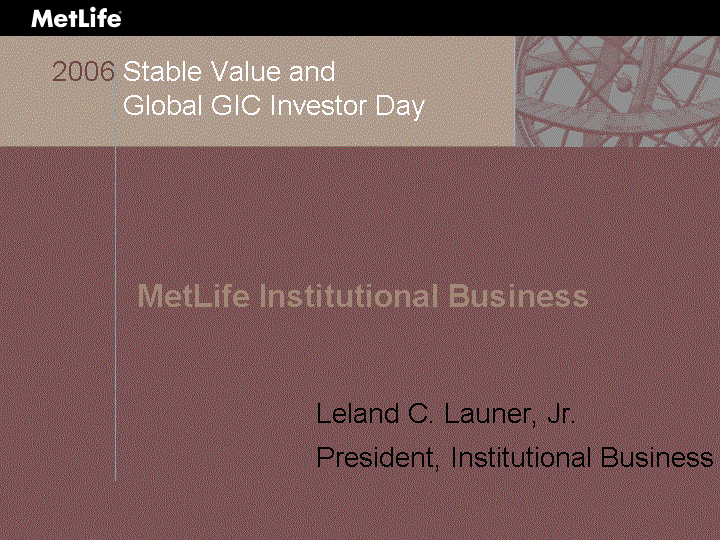
| MetLife Institutional Business Leland C. Launer, Jr. President, Institutional Business 2006 Stable Value and Global GIC Investor Day |
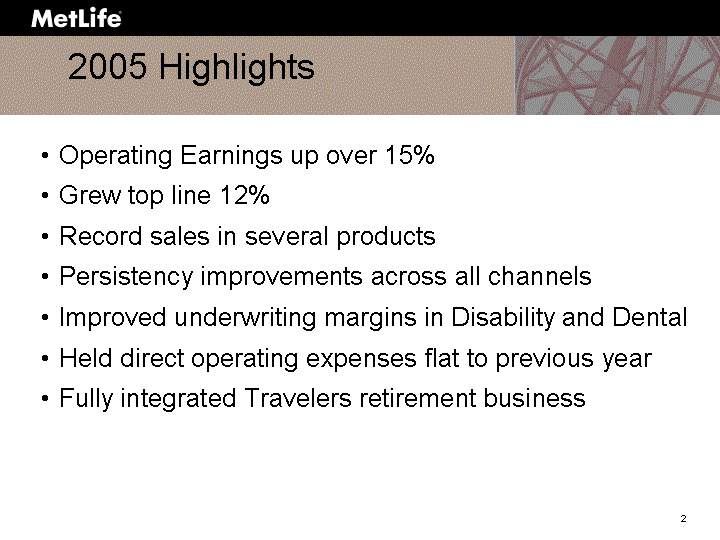
| 2005 Highlights Operating Earnings up over 15% Grew top line 12% Record sales in several products Persistency improvements across all channels Improved underwriting margins in Disability and Dental Held direct operating expenses flat to previous year Fully integrated Travelers retirement business |

| 2005 Highlights - Travelers Acquisition Purchased highly similar business Increased MetLife's retirement & savings general account assets by $28 billion or 54% Travelers accounts completely transferred to MetLife systems Providing uninterrupted service for Travelers 275,000 annuitants Managing acquired business with little incremental cost |
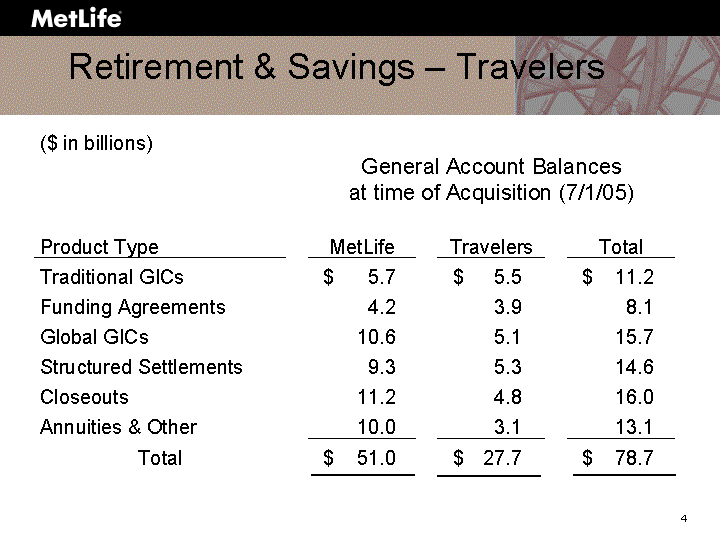
| Retirement & Savings - Travelers |

| 2005 Highlights - Key Management Actions Reorganized product groups to align with the buyer Consolidated sales forces under one leader Increased focus on "second sale" capabilities Additional focus on service |
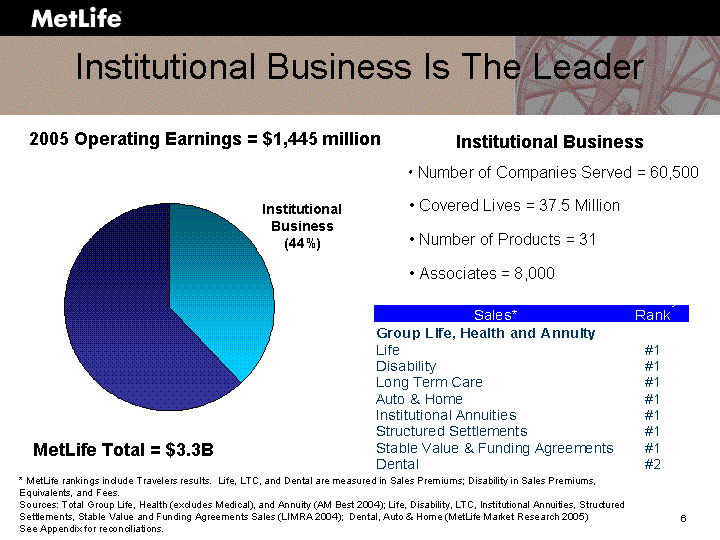
| Institutional Business Is The Leader Institutional Business (44%) 2005 Operating Earnings = $1,445 million Institutional Business Number of Companies Served = 60,500 Covered Lives = 37.5 Million Number of Products = 31 Associates = 8,000 MetLife Total = $3.3B * MetLife rankings include Travelers results. Life, LTC, and Dental are measured in Sales Premiums; Disability in Sales Premiums, Equivalents, and Fees. Sources: Total Group Life, Health (excludes Medical), and Annuity (AM Best 2004); Life, Disability, LTC, Institutional Annuities, Structured Settlements, Stable Value and Funding Agreements Sales (LIMRA 2004); Dental, Auto & Home (MetLife Market Research 2005) See Appendix for reconciliations. |
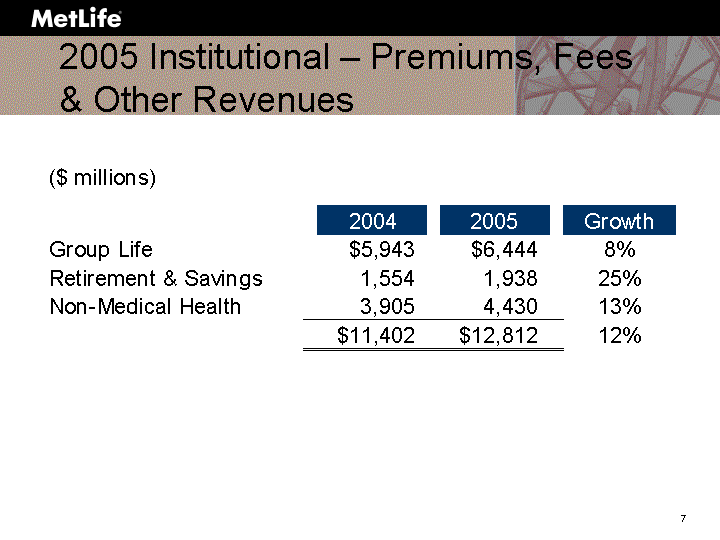
| 2005 Institutional - Premiums, Fees & Other Revenues & Other Revenues |
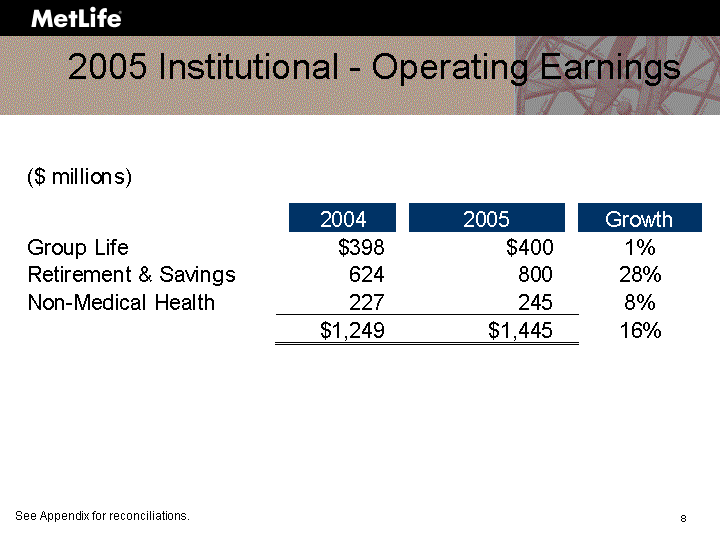
| 2005 Institutional - Operating Earnings See Appendix for reconciliations. |

| 2006 Institutional - Premiums, Fees & Other Revenues |
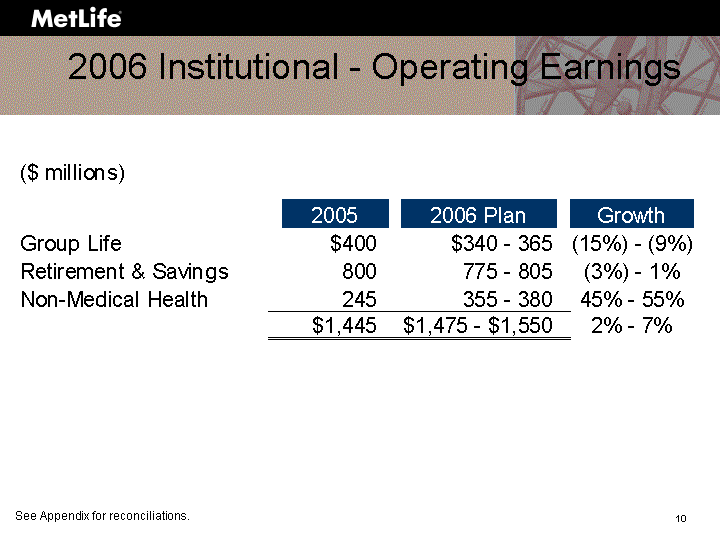
| 2006 Institutional - Operating Earnings See Appendix for reconciliations. |
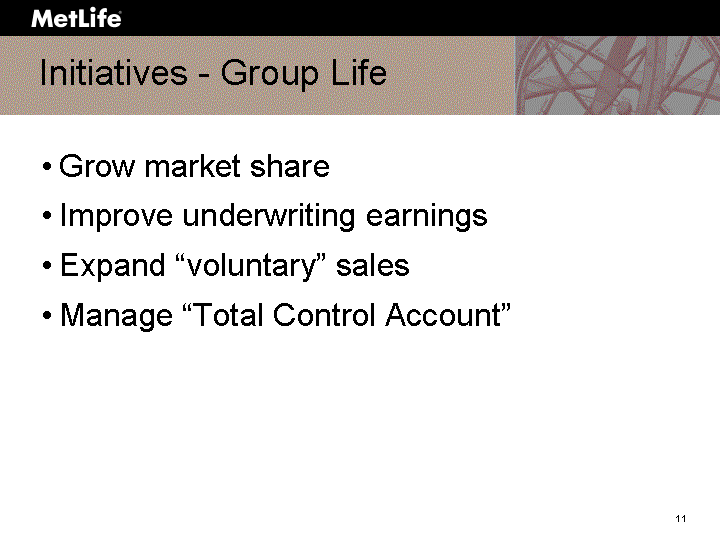
| Initiatives - Group Life Grow market share Improve underwriting earnings Expand "voluntary" sales Manage "Total Control Account" |
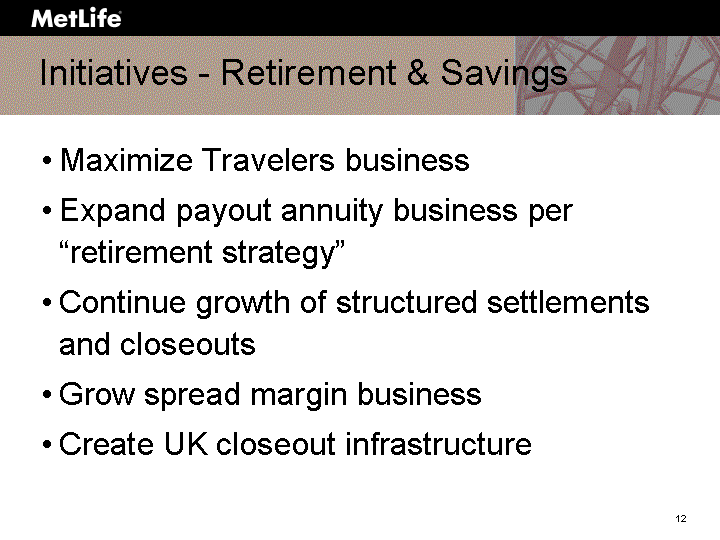
| Initiatives - Retirement & Savings Maximize Travelers business Expand payout annuity business per "retirement strategy" Continue growth of structured settlements and closeouts Grow spread margin business Create UK closeout infrastructure |
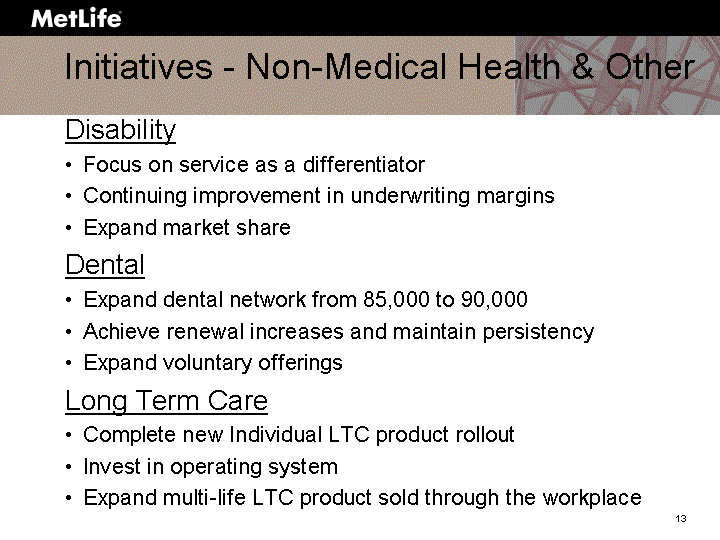
| Initiatives - Non-Medical Health & Other Disability Focus on service as a differentiator Continuing improvement in underwriting margins Expand market share Dental Expand dental network from 85,000 to 90,000 Achieve renewal increases and maintain persistency Expand voluntary offerings Long Term Care Complete new Individual LTC product rollout Invest in operating system Expand multi-life LTC product sold through the workplace |

| Future Opportunities Higher participation rates in voluntary products Market share increase in small to mid employers Re-emergence of pension closeout business Expand arbitrage business |
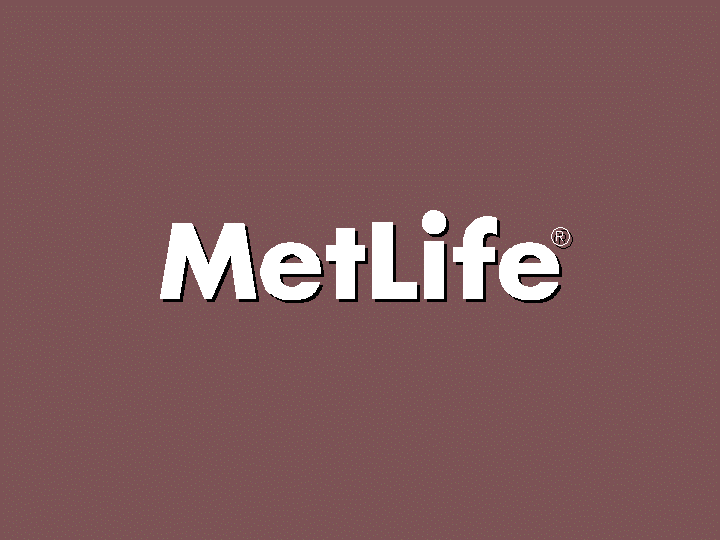
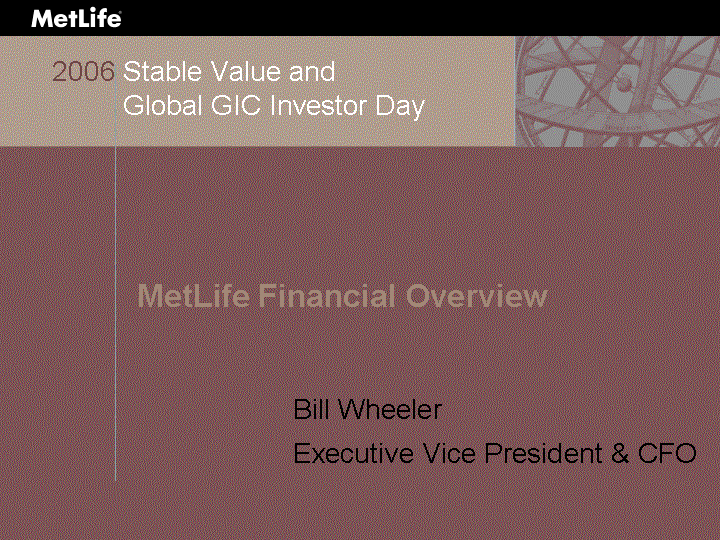
| MetLife Financial Overview Bill Wheeler Executive Vice President & CFO 2006 Stable Value and Global GIC Investor Day |
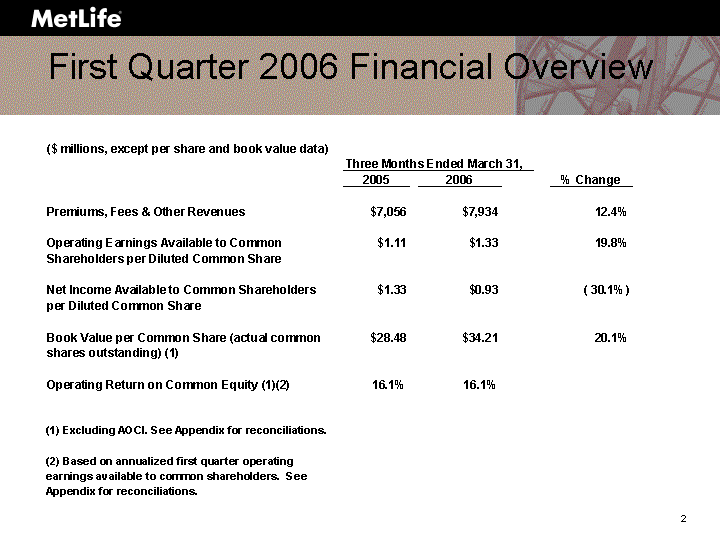
| First Quarter 2006 Financial Overview |

| Premiums, Fees & Other Revenues 2001 2002 2003 2004 2005 Q105 Q106 20157 22331 24269 26265 29959 7056 7934 CAGR 10.4% ($millions) * Excludes $32 million for Conning, a subsidiary which was sold in 2001. See Appendix for reconciliations. * 12.4% $7,056 $7,934 $20,157 $22,331 $24,269 $26,265 $29,959 7.9% Annualized Sequential Growth |
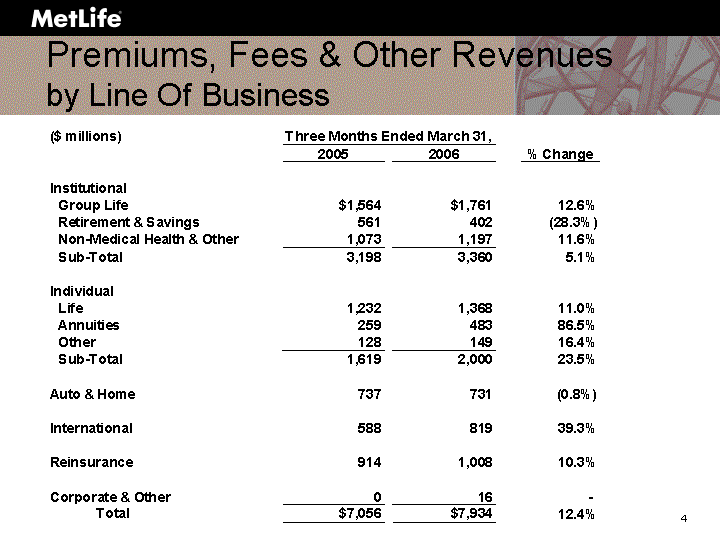
| Premiums, Fees & Other Revenues by Line Of Business |
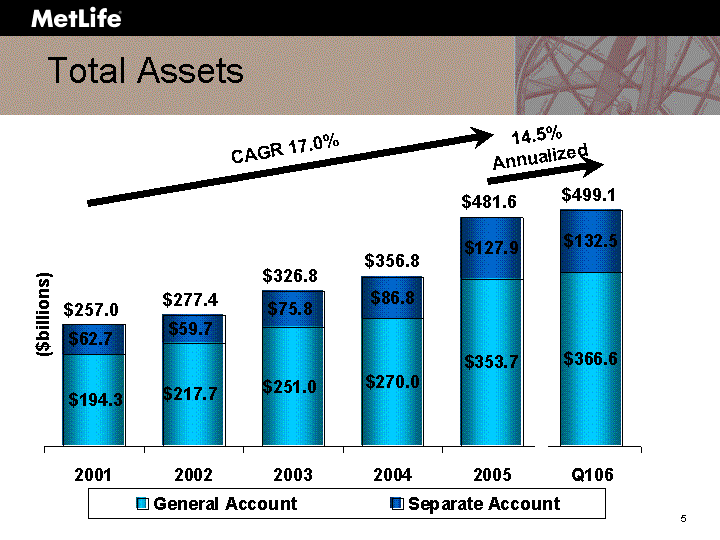
| Total Assets 2001 2002 2003 2004 2005 Q106 General Account 194.3 217.7 251 270 353.7 366.6 Separate Account 62.7 59.7 75.8 86.8 127.9 132.5 ($billions) CAGR 17.0% $326.8 $277.4 $257.0 $356.8 $481.6 $499.1 14.5% Annualized |

| Underwriting Margins - Loss Ratios |

| Investment Yields and Spreads |

| Total Company Operating Expense Ratio 2001 2002 2003 2004 2005 Q105 Q305 Q405 Q106 Operating Expense Ratio 0.295 0.278 0.278 0.28 0.28 0.257 0.302 0.32 0.286 Operating expense ratio is defined as expenses excluding certain items, divided by premiums, fees and other revenues. See Appendix for reconciliations. 29.5% 27.8% 27.8% 28.0% 28.5% 29.0% 25.7% 30.2% 32.0% |

| Operating Earnings Available to Common Shareholders Per Diluted Common Share 2001 2002 2003 2004 2005 Q105 Q106 2.17 2.59 2.77 3.35 4.33 1.11 1.35 CAGR 18.9% Operating Earnings Available to Common Shareholders Per Diluted Common Share as presented excludes certain items. See Appendix for reconciliations. 19.8% $1.11 $2.17 $3.36 $2.83 $2.59 $4.33 $1.33 |

| Operating Earnings Available to Common Shareholders by Line of Business |

| GAAP Results Total Company |
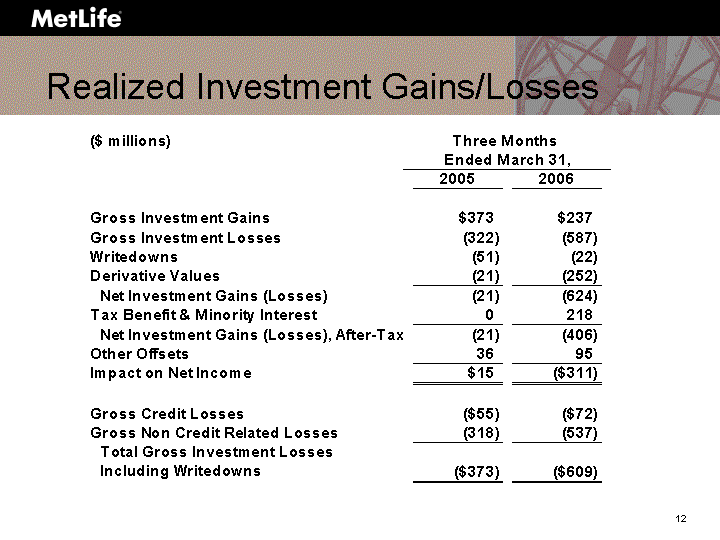
| Realized Investment Gains/Losses |
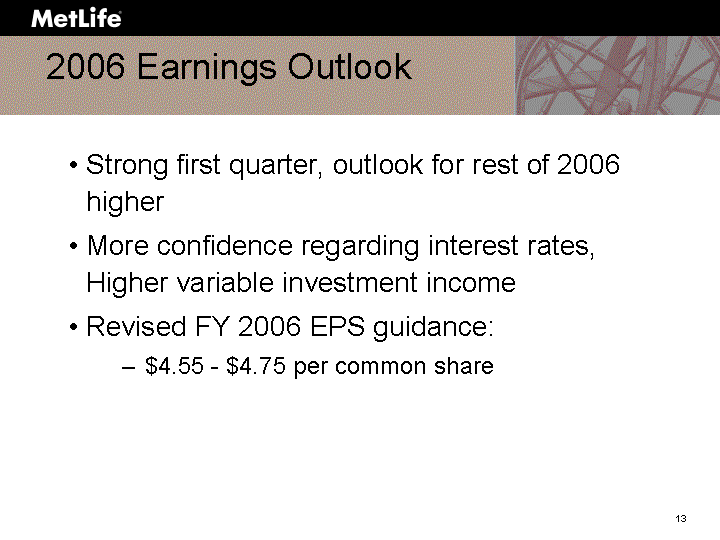
| 2006 Earnings Outlook Strong first quarter, outlook for rest of 2006 higher More confidence regarding interest rates, Higher variable investment income Revised FY 2006 EPS guidance: $4.55 - $4.75 per common share |
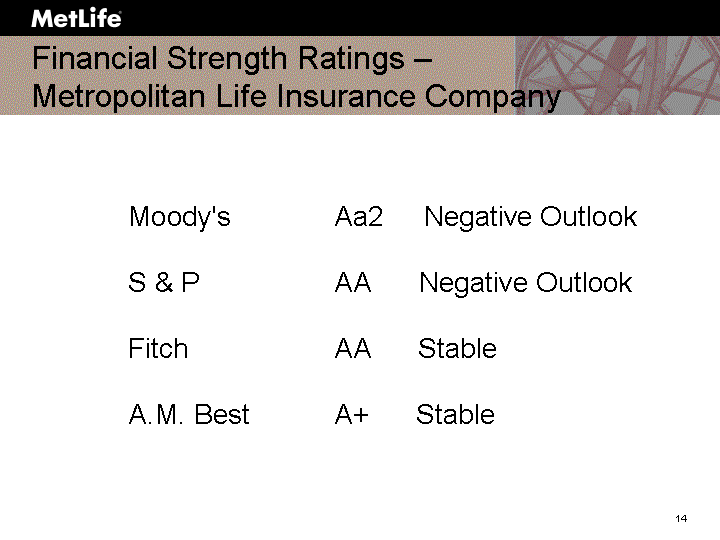
| Financial Strength Ratings - Metropolitan Life Insurance Company Moody's Aa2 Negative Outlook S & P AA Negative Outlook Fitch AA Stable A.M. Best A+ Stable |
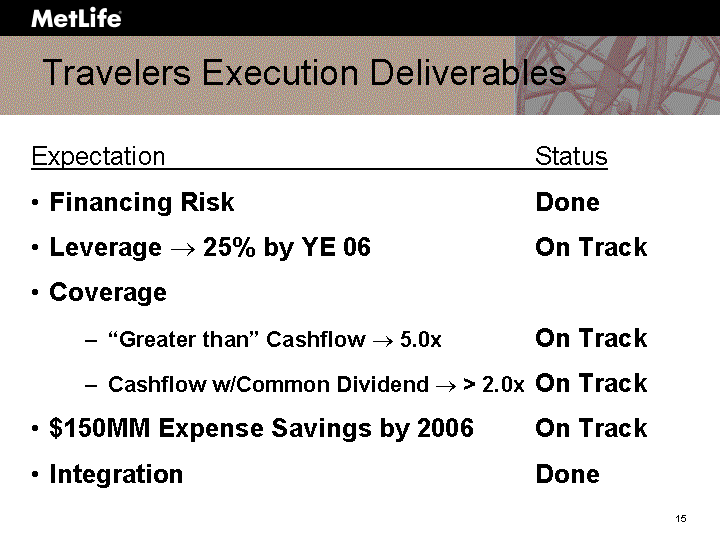
| Travelers Execution Deliverables Expectation Status Financing Risk Done Leverage ? 25% by YE 06 On Track Coverage "Greater than" Cashflow ? 5.0x On Track Cashflow w/Common Dividend ? > 2.0x On Track $150MM Expense Savings by 2006 On Track Integration Done |
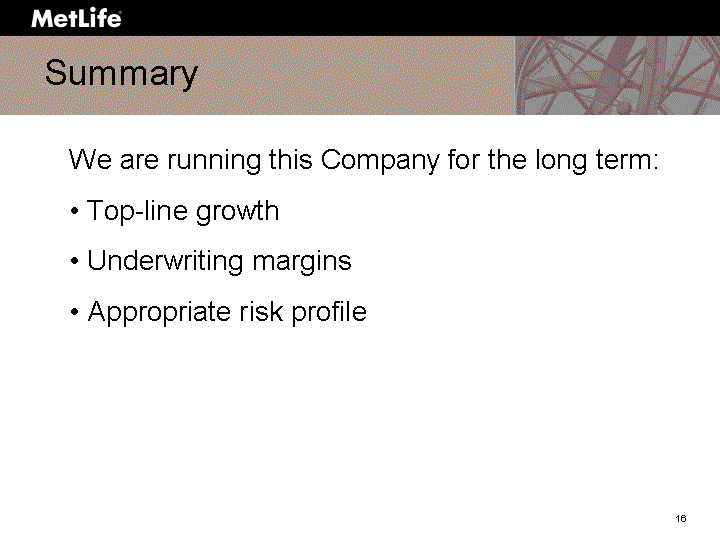
| Summary We are running this Company for the long term: Top-line growth Underwriting margins Appropriate risk profile |
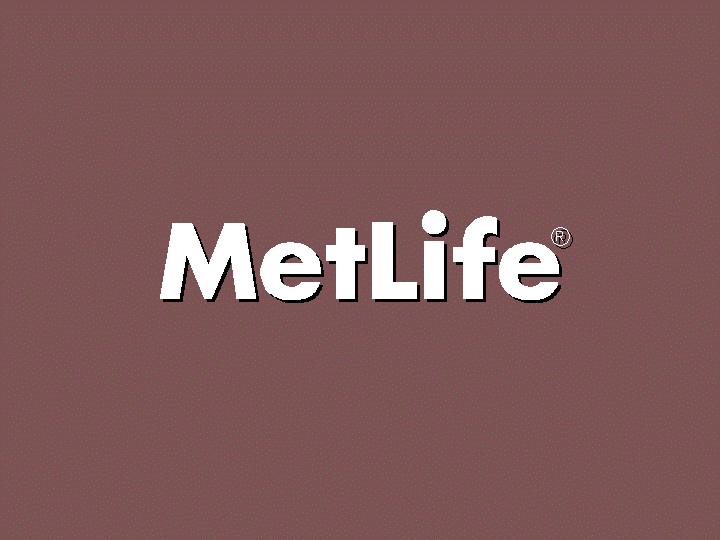
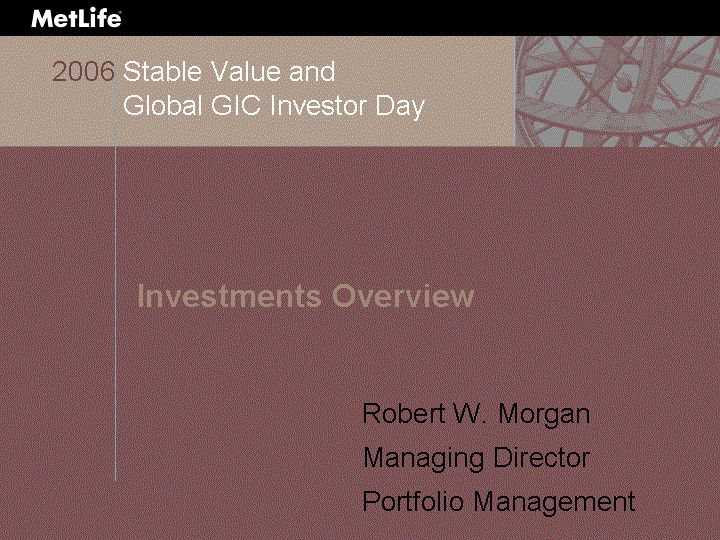
| Investments Overview Robert W. Morgan Managing Director Portfolio Management 2006 Stable Value and Global GIC Investor Day |

| Investments Agenda Market overview Portfolio asset allocation Sectors: Credit Residential mortgage-backed securities Real estate and agricultural investments Derivatives Investment risks |
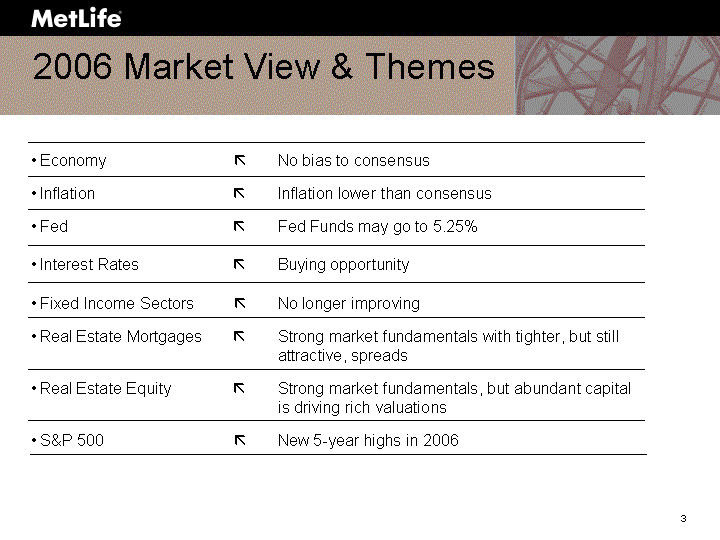
| Economy ? No bias to consensus Inflation ? Inflation lower than consensus Fed ? Fed Funds may go to 5.25% Interest Rates ? Buying opportunity Fixed Income Sectors ? No longer improving Real Estate Mortgages ? Strong market fundamentals with tighter, but still attractive, spreads Real Estate Equity ? Strong market fundamentals, but abundant capital is driving rich valuations S&P 500 ? New 5-year highs in 2006 2006 Market View & Themes |
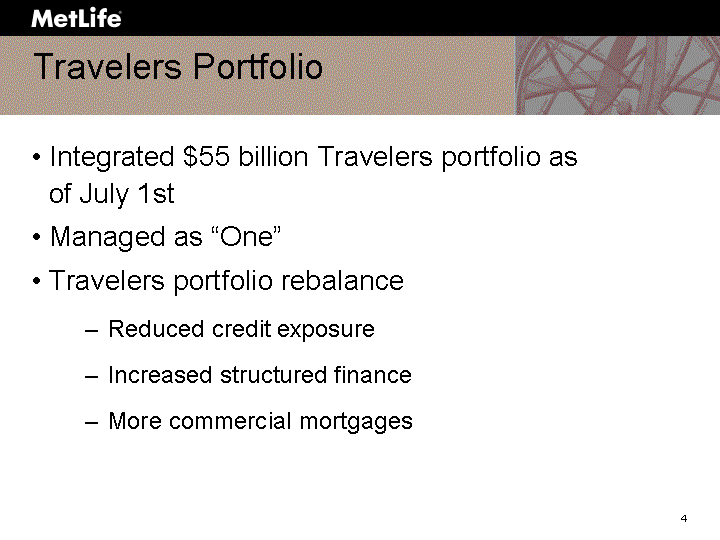
| Integrated $55 billion Travelers portfolio as of July 1st Managed as "One" Travelers portfolio rebalance Reduced credit exposure Increased structured finance More commercial mortgages Travelers Portfolio |
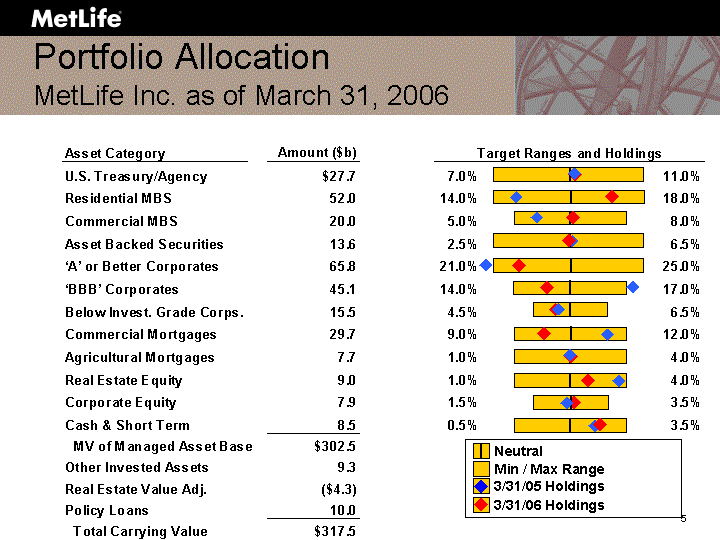
| Portfolio Allocation MetLife Inc. as of March 31, 2006 Neutral Min / Max Range 3/31/05 Holdings 3/31/06 Holdings |
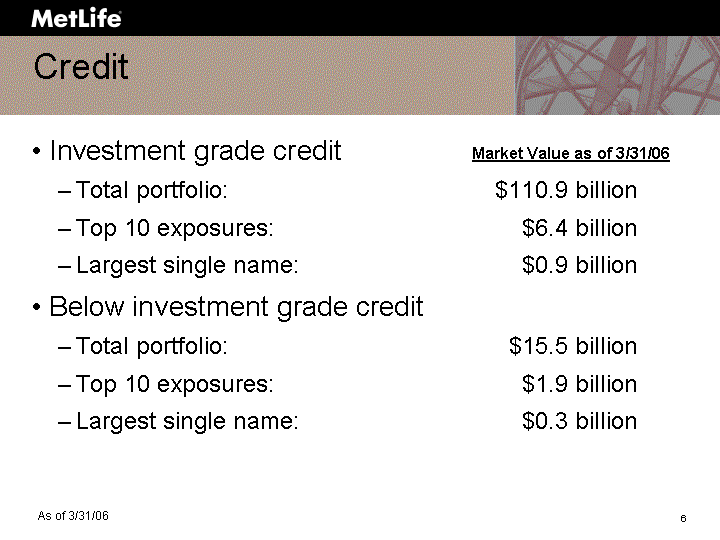
| Investment grade credit Total portfolio: $110.9 billion Top 10 exposures: $6.4 billion Largest single name: $0.9 billion Below investment grade credit Total portfolio: $15.5 billion Top 10 exposures: $1.9 billion Largest single name: $0.3 billion Credit As of 3/31/06 Market Value as of 3/31/06 |
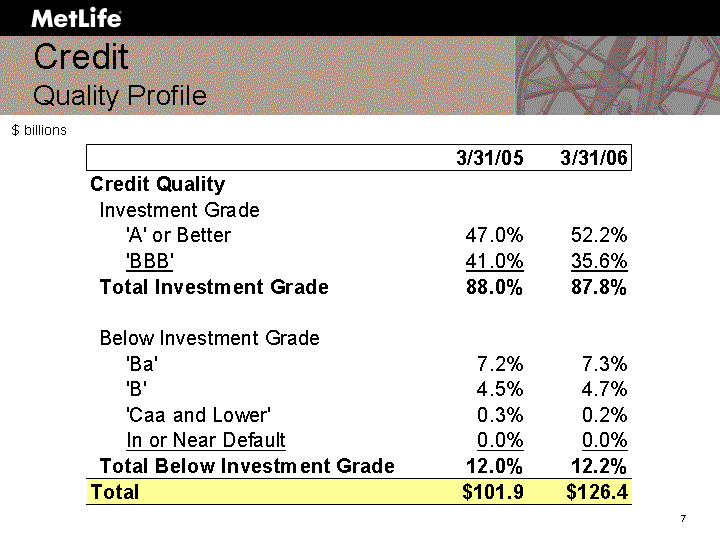
| $ billions Credit Quality Profile |

| Portfolio is more diversified than overall market MetLife Lehman Index Weighted average rating A3 A2 Number of issuers (ex. munis) 1,120 598 Foreign % 31.8% 27.1% Highest single exposure 0.8% 2.9% Top 10 exposures 5.7% 19.3% Credit Investment Grade As of 3/31/06 |
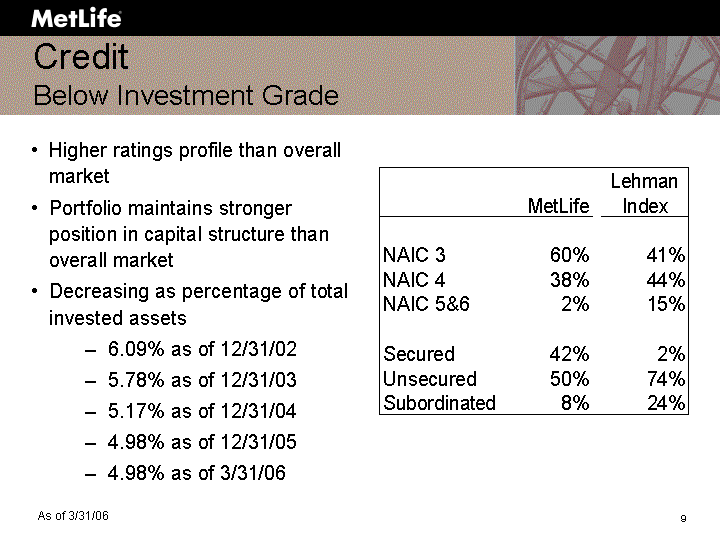
| Higher ratings profile than overall market Portfolio maintains stronger position in capital structure than overall market Decreasing as percentage of total invested assets 6.09% as of 12/31/02 5.78% as of 12/31/03 5.17% as of 12/31/04 4.98% as of 12/31/05 4.98% as of 3/31/06 Credit Below Investment Grade As of 3/31/06 |
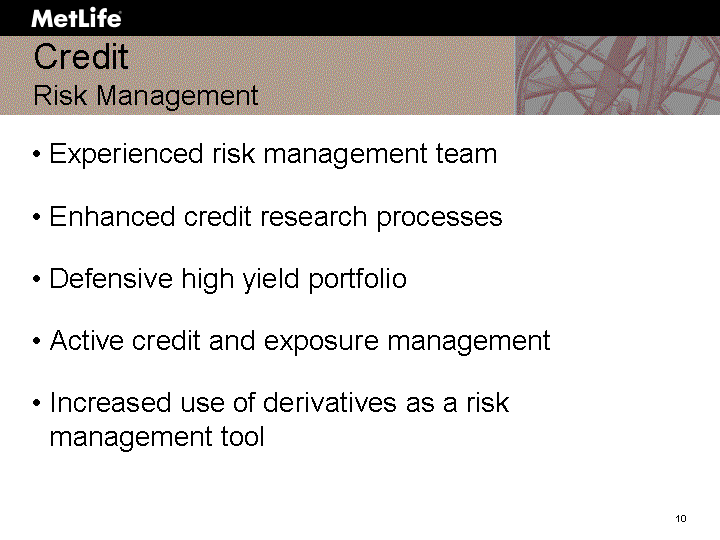
| Experienced risk management team Enhanced credit research processes Defensive high yield portfolio Active credit and exposure management Increased use of derivatives as a risk management tool Credit Risk Management |
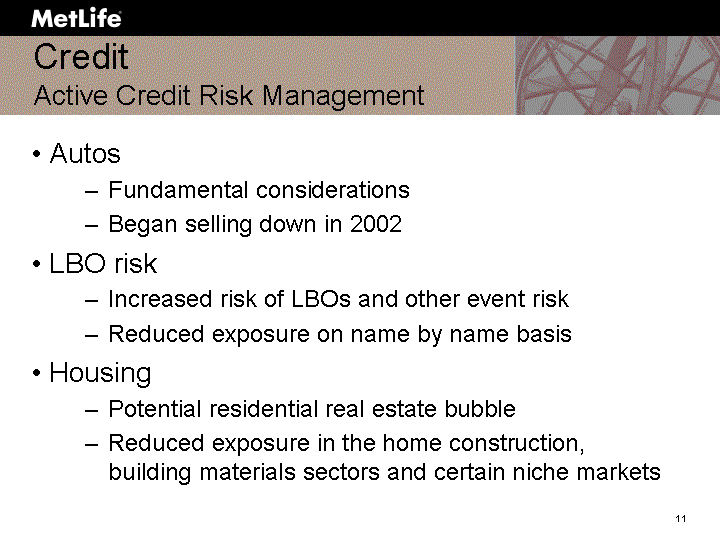
| Autos Fundamental considerations Began selling down in 2002 LBO risk Increased risk of LBOs and other event risk Reduced exposure on name by name basis Housing Potential residential real estate bubble Reduced exposure in the home construction, building materials sectors and certain niche markets Credit Active Credit Risk Management |
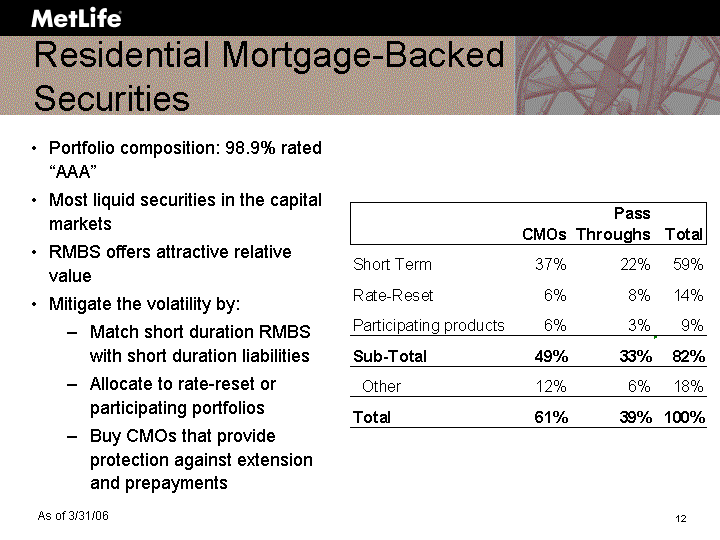
| Portfolio composition: 98.9% rated "AAA" Most liquid securities in the capital markets RMBS offers attractive relative value Mitigate the volatility by: Match short duration RMBS with short duration liabilities Allocate to rate-reset or participating portfolios Buy CMOs that provide protection against extension and prepayments Residential Mortgage-Backed Securities As of 3/31/06 |
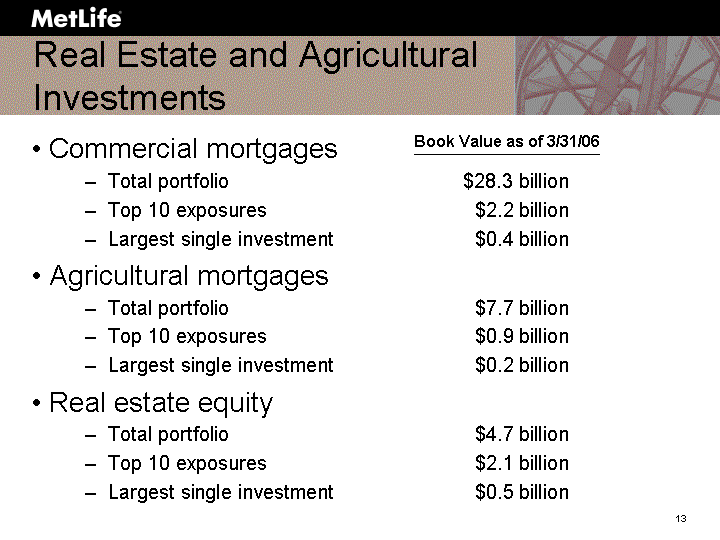
| Commercial mortgages Total portfolio $28.3 billion Top 10 exposures $2.2 billion Largest single investment $0.4 billion Agricultural mortgages Total portfolio $7.7 billion Top 10 exposures $0.9 billion Largest single investment $0.2 billion Real estate equity Total portfolio $4.7 billion Top 10 exposures $2.1 billion Largest single investment $0.5 billion Real Estate and Agricultural Investments Book Value as of 3/31/06 |
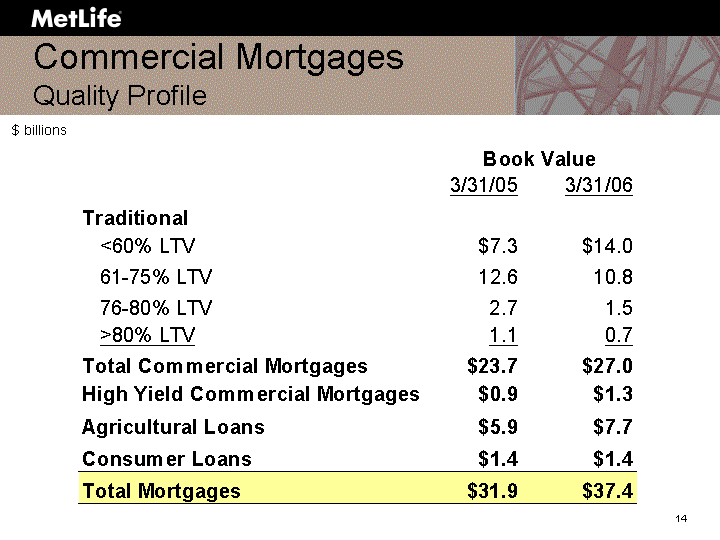
| Commercial Mortgages Quality Profile $ billions |
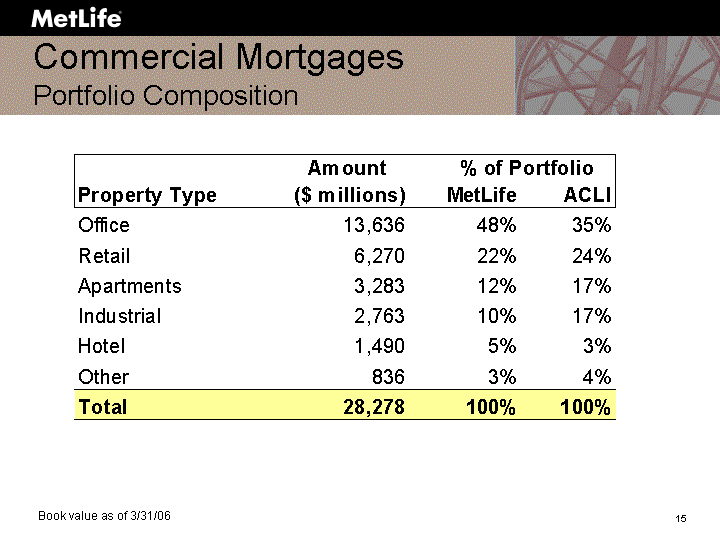
| Commercial Mortgages Portfolio Composition Book value as of 3/31/06 |
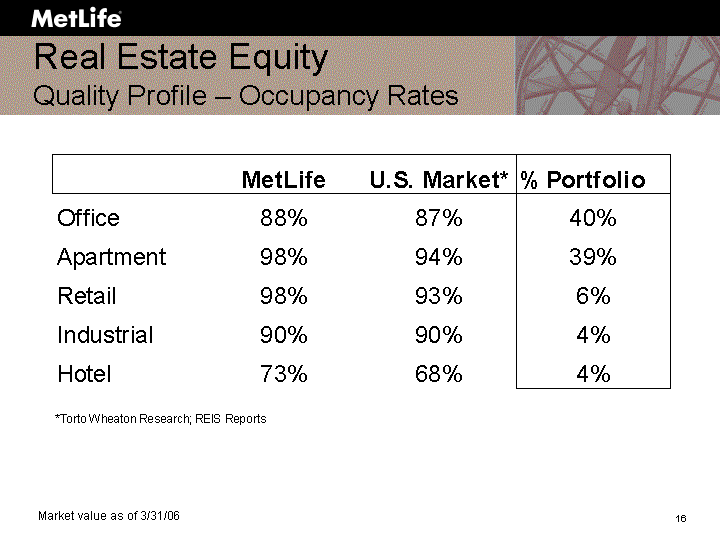
| Real Estate Equity Quality Profile - Occupancy Rates Market value as of 3/31/06 |

| Derivatives 97% of derivatives used for hedging purposes Duration management Rate hedges Foreign currency hedges $ millions |
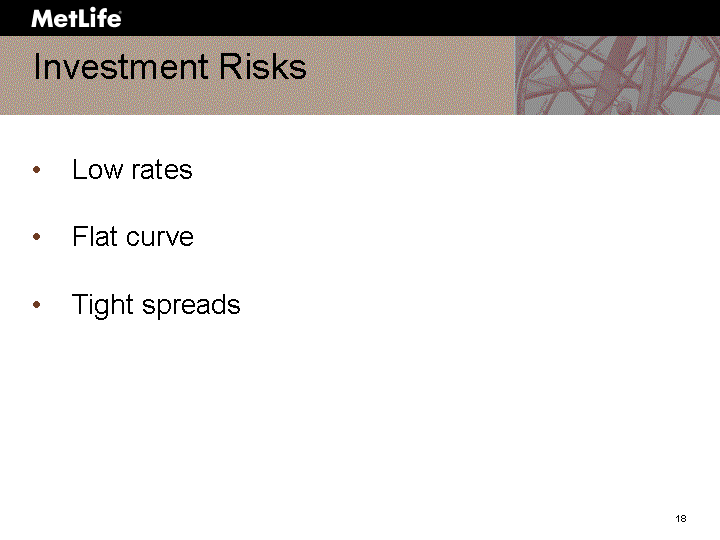
| Investment Risks Low rates Flat curve Tight spreads |
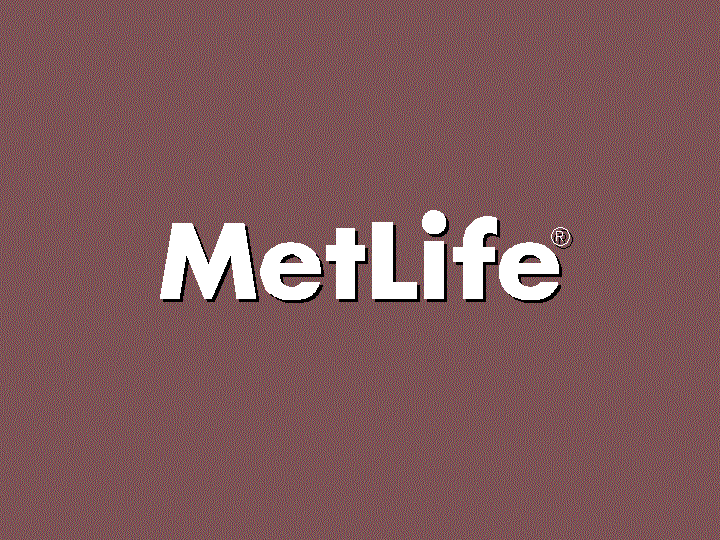
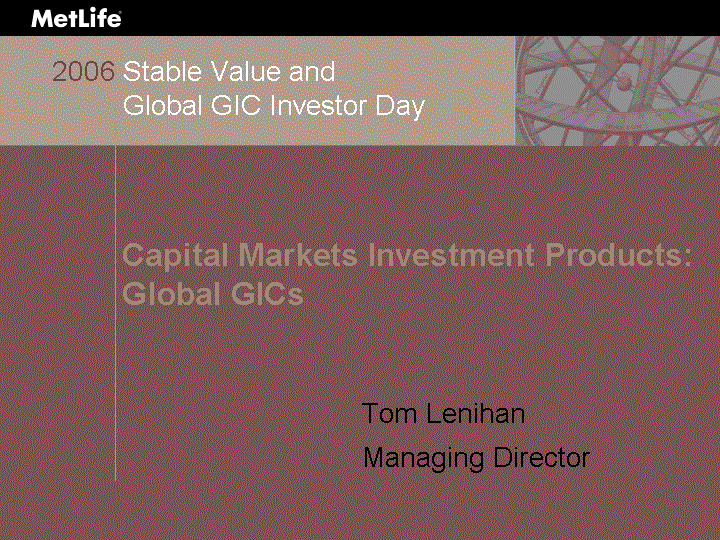
| Capital Markets Investment Products: Global GICs Tom Lenihan Managing Director 2006 Stable Value and Global GIC Investor Day |
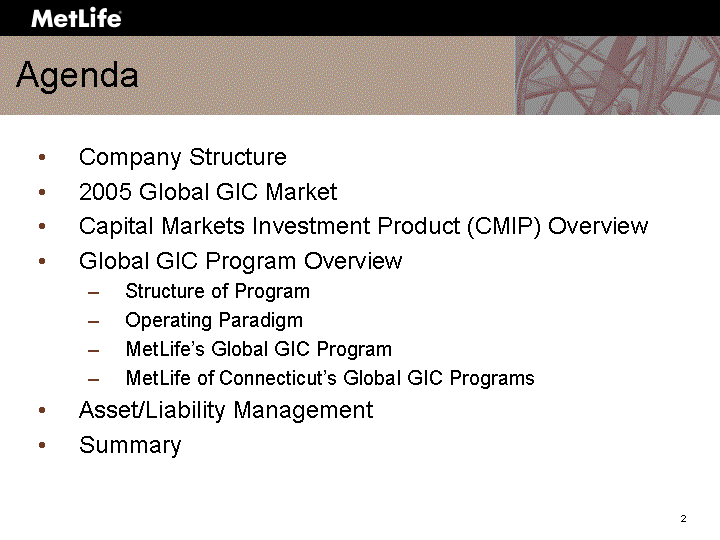
| Agenda Company Structure 2005 Global GIC Market Capital Markets Investment Product (CMIP) Overview Global GIC Program Overview Structure of Program Operating Paradigm MetLife's Global GIC Program MetLife of Connecticut's Global GIC Programs Asset/Liability Management Summary |
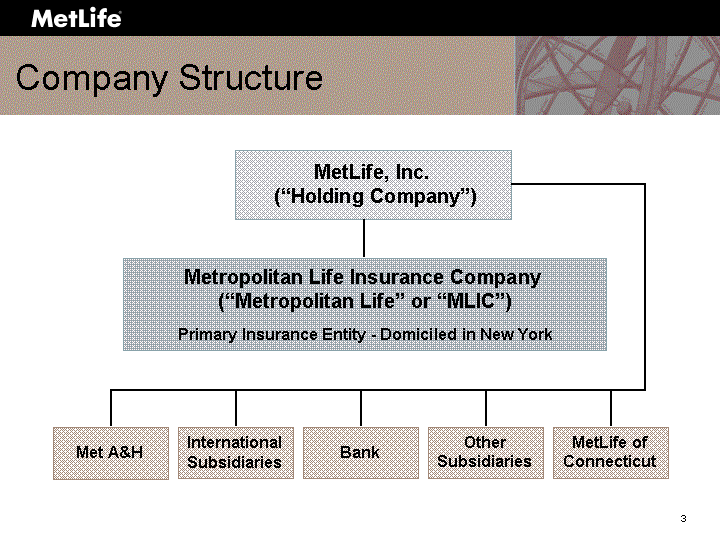
| Company Structure MetLife, Inc. ("Holding Company") International Subsidiaries Other Subsidiaries Bank Met A&H MetLife of Connecticut Metropolitan Life Insurance Company ("Metropolitan Life" or "MLIC") Primary Insurance Entity - Domiciled in New York |

| 2005 Global GIC Market Recap 18 programs issued a total of $32.1 billion of notes New issue volume decreased by $5.5 billion versus 2004 due to AIG's departure from the market Over $200 billion of notes have been offered since 1997 ($145 billion currently outstanding) Issuance through SEC-registered programs continued to expand as it accounted for 28% of the 2005 new issue volume With over $25 billion of maturities projected in 2006 and continued growth expected, issuances likely to remain robust in 2006 *Data published by S&P. GGIC ISSUANCE BY YEAR* |
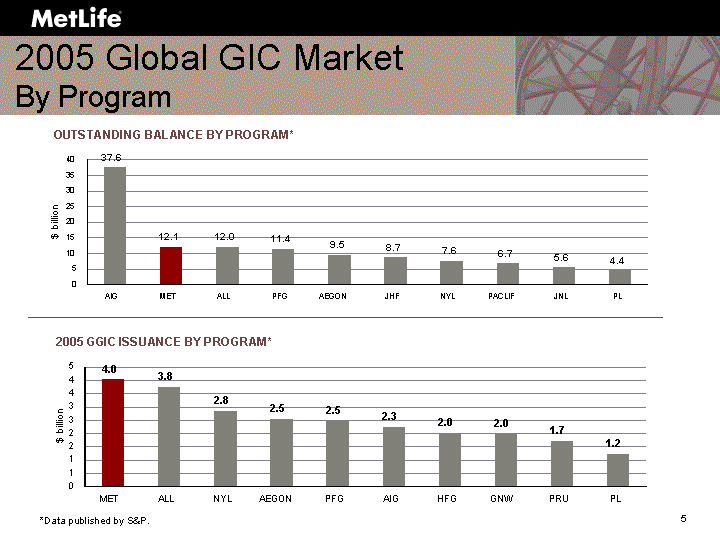
| 2005 Global GIC Market By Program *Data published by S&P. OUTSTANDING BALANCE BY PROGRAM* 2005 GGIC ISSUANCE BY PROGRAM* |

| CMIP Overview MLIC's GGICs MetLife of Connecticut's GGICs Farmer Mac Guaranteed Trust Notes Short Term Funding Agreements |
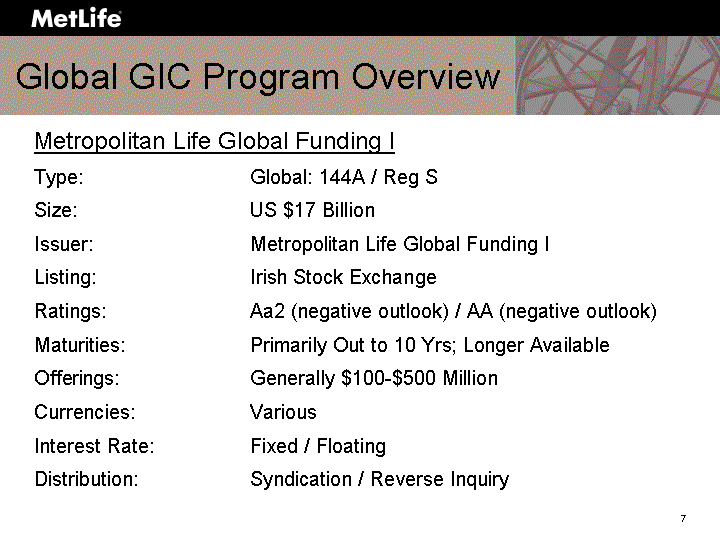
| Global GIC Program Overview Metropolitan Life Global Funding I Type: Global: 144A / Reg S Size: US $17 Billion Issuer: Metropolitan Life Global Funding I Listing: Irish Stock Exchange Ratings: Aa2 (negative outlook) / AA (negative outlook) Maturities: Primarily Out to 10 Yrs; Longer Available Offerings: Generally $100-$500 Million Currencies: Various Interest Rate: Fixed / Floating Distribution: Syndication / Reverse Inquiry |

| Structure of Program Standard Global Format Metropolitan Life Global Funding I Investors Investment Bank $ Metropolitan Life** $ $ Notes* Funding Agreement Funding Agreement * Notes rated Aa2/AA. ** Metropolitan Life Financial Strength Ratings: Aa2/AA. |
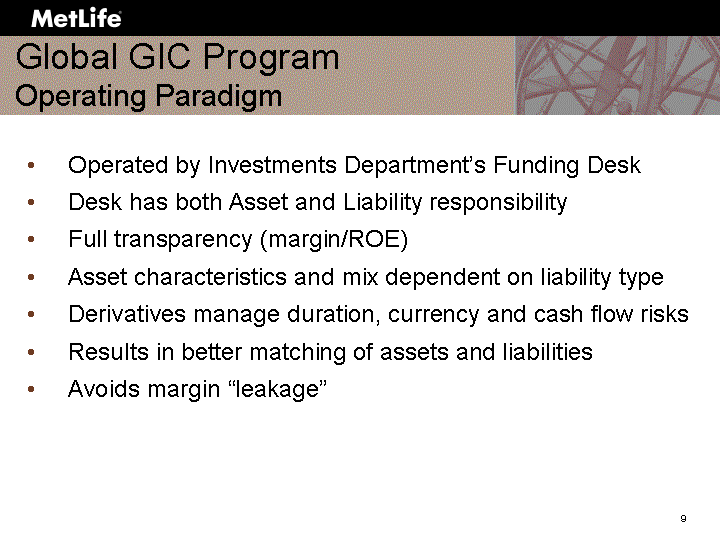
| Operated by Investments Department's Funding Desk Desk has both Asset and Liability responsibility Full transparency (margin/ROE) Asset characteristics and mix dependent on liability type Derivatives manage duration, currency and cash flow risks Results in better matching of assets and liabilities Avoids margin "leakage" Global GIC Program Operating Paradigm |

| 40 discrete transactions totaling $14 billion since program inception (June 2002) Outstanding balance totaled US $12.1 billion Issuance: 73% USD/16% GBP/7% CHF/3% CAD/1% JPY Planned annual new issuance of $3-5 billion Diversification: markets and currencies Utilize a broad group of bankers Program has reached over 265 investors globally MLIC's GGIC Program As of 3/31/2006 |
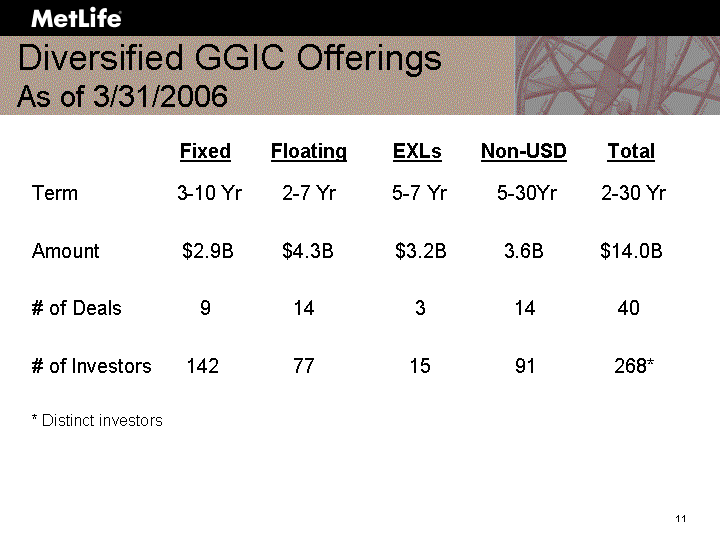
| Diversified GGIC Offerings As of 3/31/2006 Fixed Floating EXLs Non-USD Total Term 3-10 Yr 2-7 Yr 5-7 Yr 5-30Yr 2-30 Yr Amount $2.9B $4.3B $3.2B 3.6B $14.0B # of Deals 9 14 3 14 40 # of Investors 142 77 15 91 268* * Distinct investors |
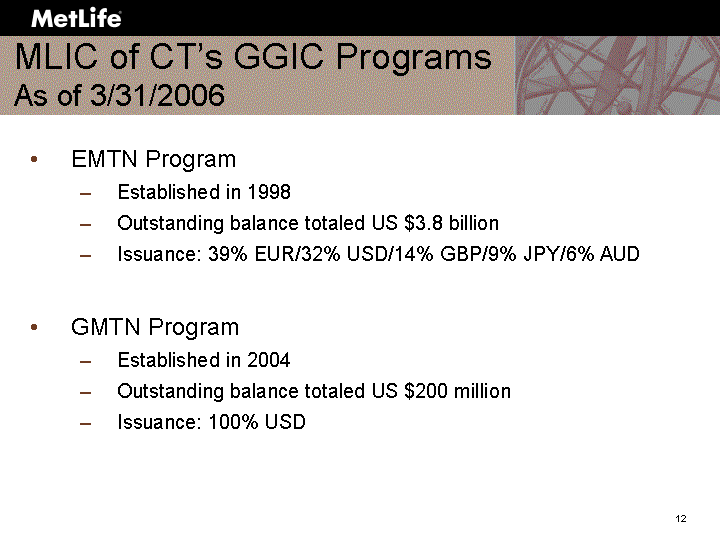
| EMTN Program Established in 1998 Outstanding balance totaled US $3.8 billion Issuance: 39% EUR/32% USD/14% GBP/9% JPY/6% AUD GMTN Program Established in 2004 Outstanding balance totaled US $200 million Issuance: 100% USD MLIC of CT's GGIC Programs As of 3/31/2006 |

| Rating agencies require "matched book" style Duration framework: ALM = +- 0.5 years Diversification: broad use of asset sectors; laddered maturities for liabilities Securities selection/management: extensive use of research, trading, and private market capabilities Asset portfolio quality: "A" rated overall; economic capital usage is less than company average Asset/Liability Management GGIC Program Framework |
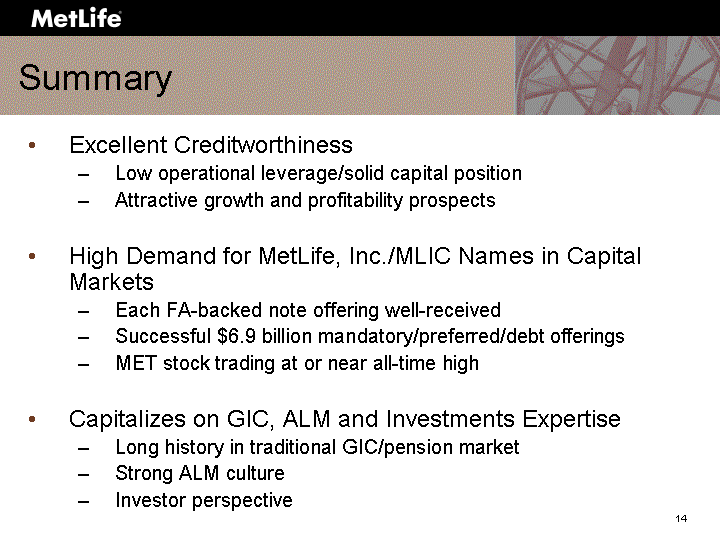
| Excellent Creditworthiness Low operational leverage/solid capital position Attractive growth and profitability prospects High Demand for MetLife, Inc./MLIC Names in Capital Markets Each FA-backed note offering well-received Successful $6.9 billion mandatory/preferred/debt offerings MET stock trading at or near all-time high Capitalizes on GIC, ALM and Investments Expertise Long history in traditional GIC/pension market Strong ALM culture Investor perspective Summary |

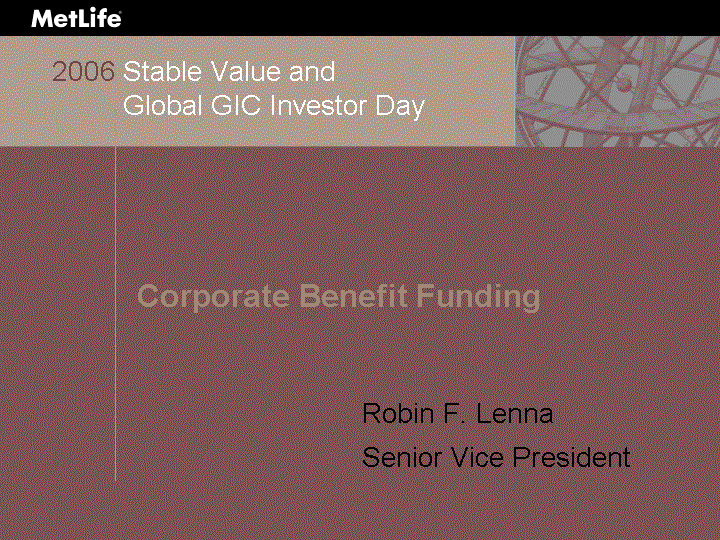
| Corporate Benefit Funding Robin F. Lenna Senior Vice President 2006 Stable Value and Global GIC Investor Day |
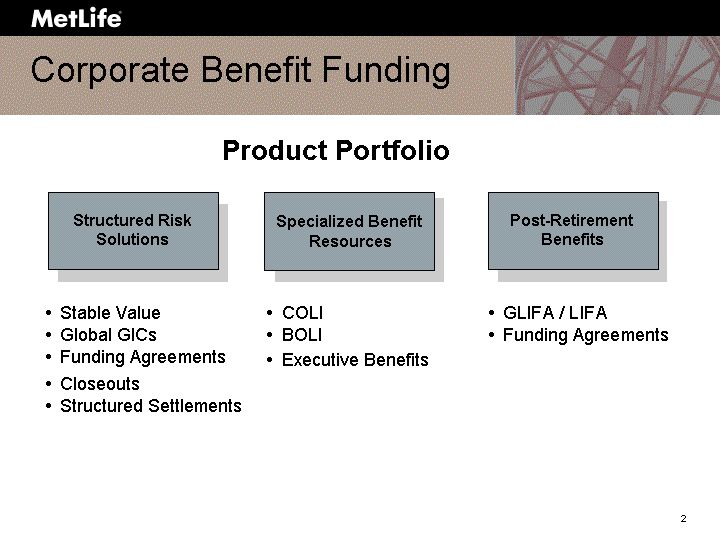
| Corporate Benefit Funding Specialized Benefit Resources Post-Retirement Benefits Structured Risk Solutions Y GLIFA / LIFA Y Funding Agreements Y COLI Y BOLI Y Executive Benefits Y Stable Value Y Global GICs Y Funding Agreements Y Closeouts Y Structured Settlements Product Portfolio |
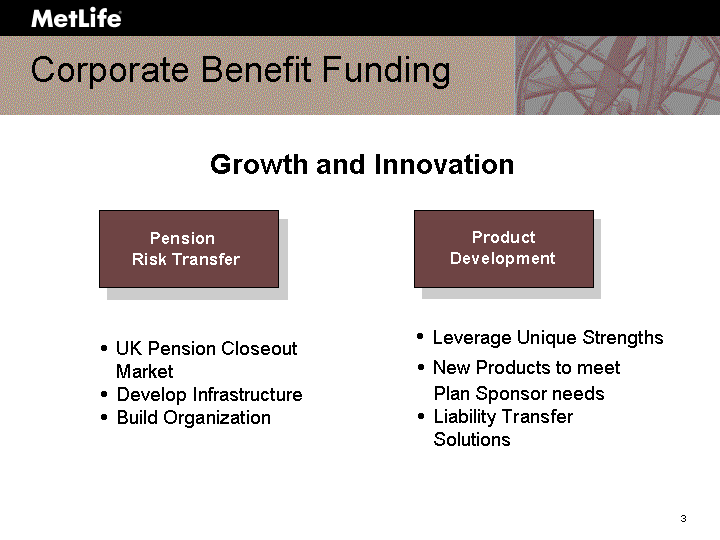
| Corporate Benefit Funding Growth and Innovation Product Development Pension Risk Transfer Y New Products to meet Plan Sponsor needs Y Liability Transfer Solutions Y UK Pension Closeout Market Y Develop Infrastructure Y Build Organization Leverage Unique Strengths Y |
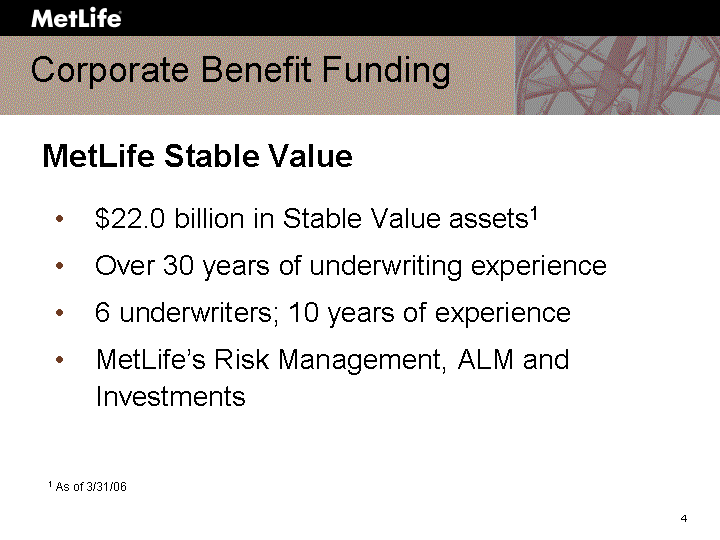
| Corporate Benefit Funding $22.0 billion in Stable Value assets1 Over 30 years of underwriting experience 6 underwriters; 10 years of experience MetLife's Risk Management, ALM and Investments MetLife Stable Value 1 As of 3/31/06 |
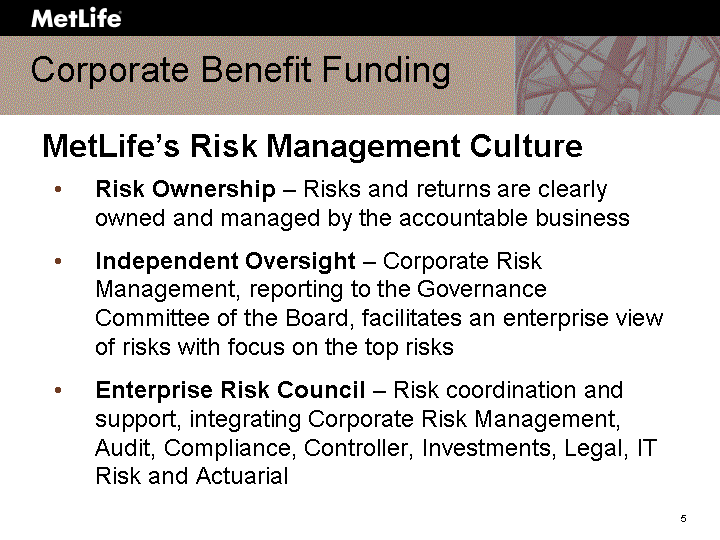
| Corporate Benefit Funding Risk Ownership - Risks and returns are clearly owned and managed by the accountable business Independent Oversight - Corporate Risk Management, reporting to the Governance Committee of the Board, facilitates an enterprise view of risks with focus on the top risks Enterprise Risk Council - Risk coordination and support, integrating Corporate Risk Management, Audit, Compliance, Controller, Investments, Legal, IT Risk and Actuarial MetLife's Risk Management Culture |
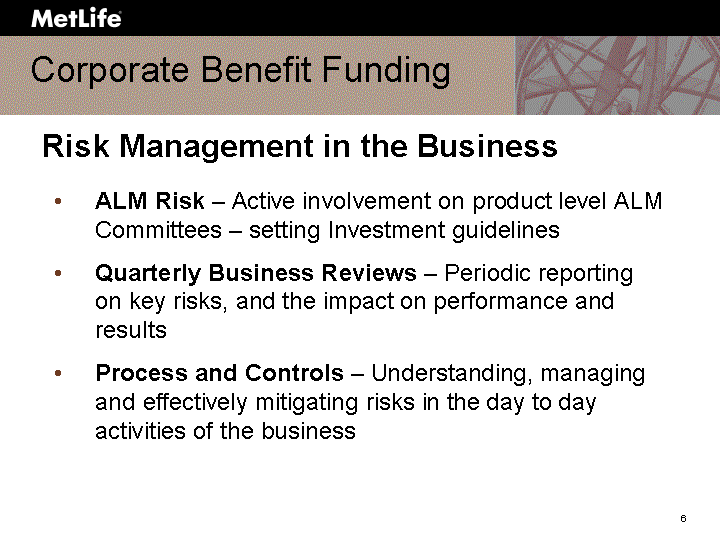
| Corporate Benefit Funding ALM Risk - Active involvement on product level ALM Committees - setting Investment guidelines Quarterly Business Reviews - Periodic reporting on key risks, and the impact on performance and results Process and Controls - Understanding, managing and effectively mitigating risks in the day to day activities of the business Risk Management in the Business |
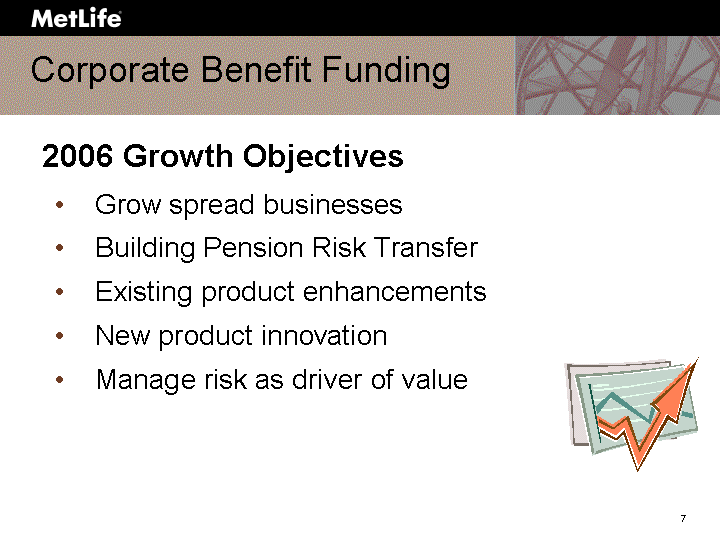
| Corporate Benefit Funding Grow spread businesses Building Pension Risk Transfer Existing product enhancements New product innovation Manage risk as driver of value 2006 Growth Objectives |
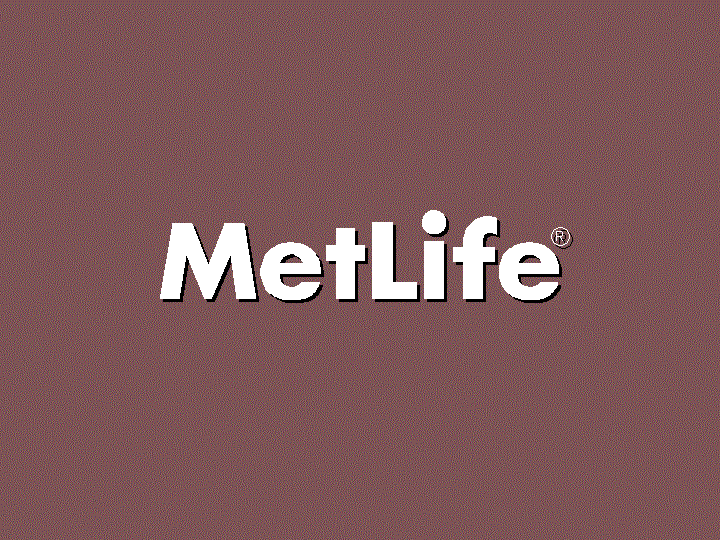

| Reconciliations of Non-GAAP Financial Information 2006 Stable Value and Global GIC Investor Day |

| Explanatory Note on Non-GAAP Financial Information The historical and forward-looking financial information presented at this conference and contained in the written materials provided include performance measures which are based on methodologies other than Generally Accepted Accounting Principles ("GAAP"). MetLife analyzes its performance using so-called non-GAAP measures, including operating earnings available to common shareholders, operating earnings available to common shareholders per diluted common share and operating return on common equity ("ROE"). MetLife believes these measures enhance the understanding and comparability of its performance by excluding net investment gains and losses, net of income taxes, and adjustments related to net investment gains and losses, net of income taxes, both of which can fluctuate significantly from period to period, the impact of the cumulative effect of a change in accounting, net of income taxes, and discontinued operations other than discontinued real estate, net of income taxes, thereby highlighting the results from operations and the underlying profitability drivers of the business. Operating earnings available to common shareholders is defined as GAAP net income, excluding net investment gains and losses, net of income taxes, adjustments related to net investment gains and losses, net of income taxes, the impact of the cumulative effect of a change in accounting, net of income taxes, and discontinued operations other than discontinued real estate, net of income taxes, less preferred stock dividends which are recorded in Corporate & Other. Scheduled settlement payments on derivative instruments not qualifying for hedge accounting treatment are included in operating earnings available to common shareholders. Operating earnings available to common shareholders per diluted common share is calculated by dividing operating earnings available to common shareholders as defined above by the number of weighted average diluted common shares outstanding for the period indicated. Operating return on common equity is calculated by dividing operating earnings available to common shareholders as defined above by average equity for the period indicated, excluding accumulated other comprehensive income. |
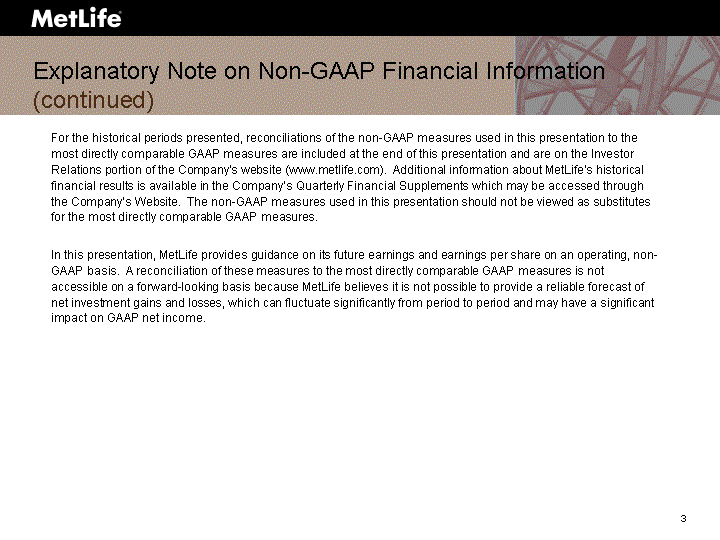
| Explanatory Note on Non-GAAP Financial Information (continued) For the historical periods presented, reconciliations of the non-GAAP measures used in this presentation to the most directly comparable GAAP measures are included at the end of this presentation and are on the Investor Relations portion of the Company's website (www.metlife.com). Additional information about MetLife's historical financial results is available in the Company's Quarterly Financial Supplements which may be accessed through the Company's Website. The non-GAAP measures used in this presentation should not be viewed as substitutes for the most directly comparable GAAP measures. In this presentation, MetLife provides guidance on its future earnings and earnings per share on an operating, non- GAAP basis. A reconciliation of these measures to the most directly comparable GAAP measures is not accessible on a forward-looking basis because MetLife believes it is not possible to provide a reliable forecast of net investment gains and losses, which can fluctuate significantly from period to period and may have a significant impact on GAAP net income. |
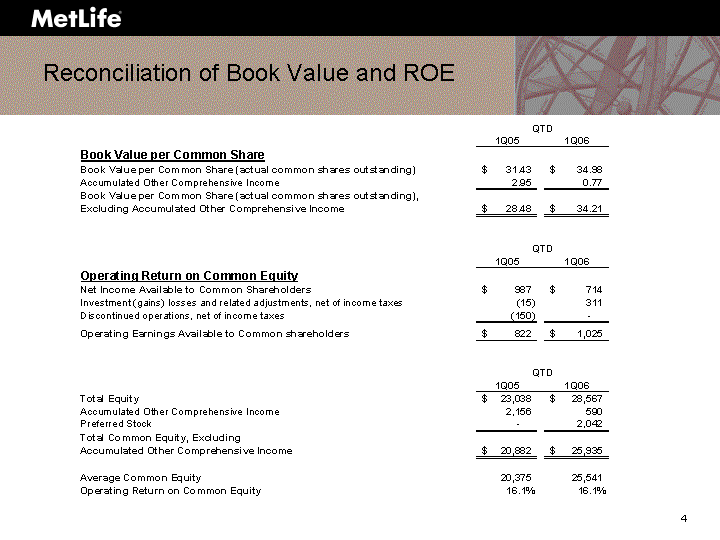
| Reconciliation of Book Value and ROE Reconciliation of Book Value and ROE |
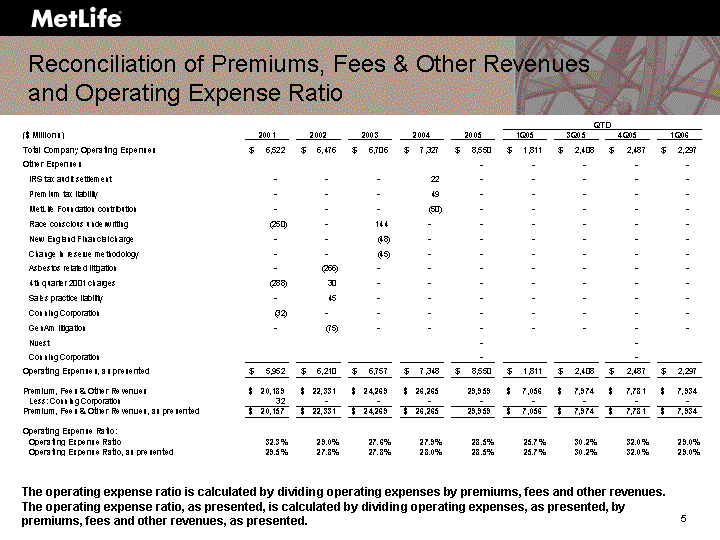
| Reconciliation of Premiums, Fees & Other Revenues and Operating Expense Ratio The operating expense ratio is calculated by dividing operating expenses by premiums, fees and other revenues. The operating expense ratio, as presented, is calculated by dividing operating expenses, as presented, by premiums, fees and other revenues, as presented. premiums, fees and other revenues, as presented. premiums, fees and other revenues, as presented. premiums, fees and other revenues, as presented. |
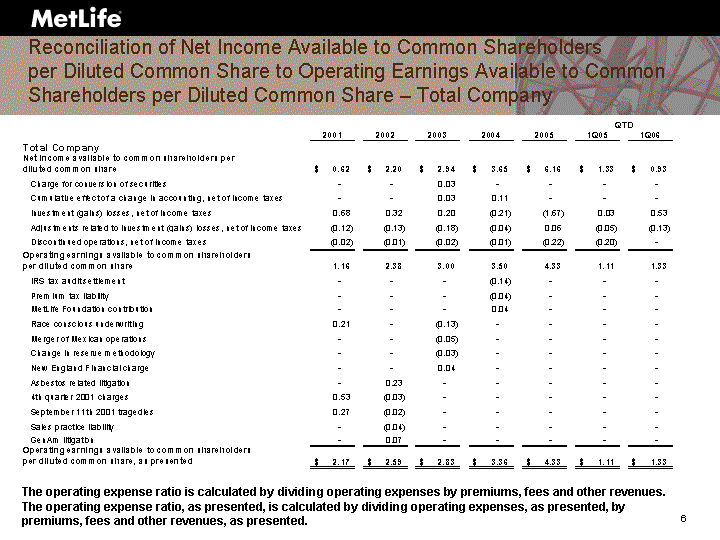
| The operating expense ratio is calculated by dividing operating expenses by premiums, fees and other revenues. The operating expense ratio, as presented, is calculated by dividing operating expenses, as presented, by premiums, fees and other revenues, as presented. |
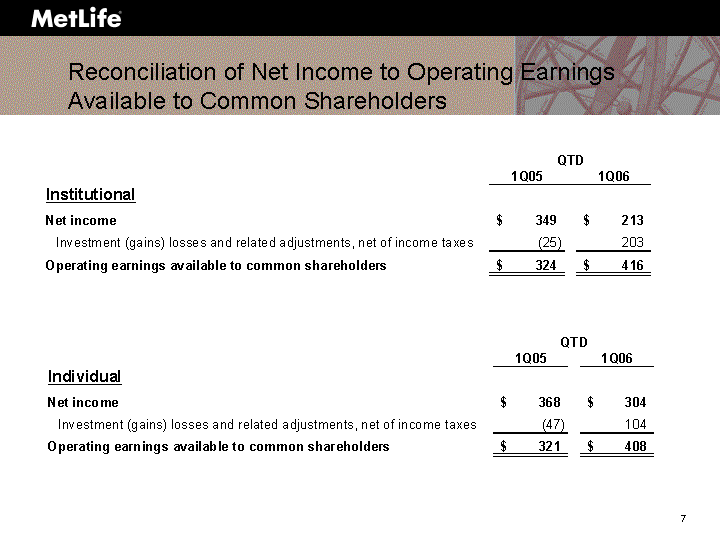
| Reconciliation of Net Income to Operating Earnings Available to Common Shareholders Available to Common Shareholders Available to Common Shareholders Available to Common Shareholders Available to Common Shareholders |
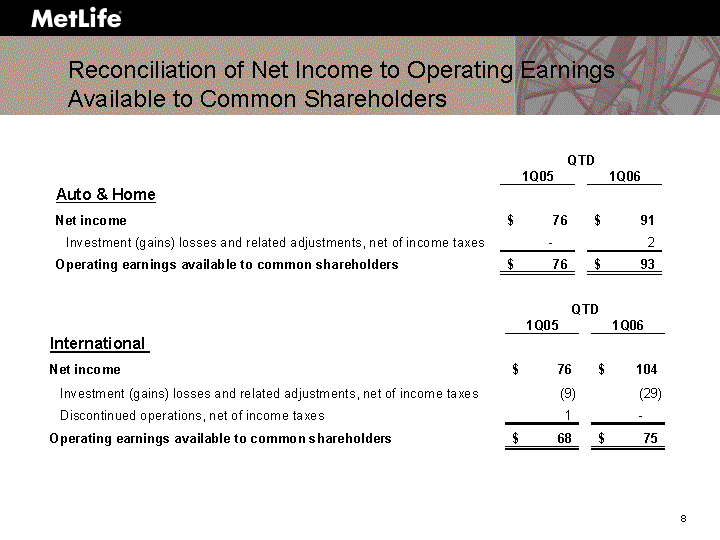
| Reconciliation of Net Income to Operating Earnings Available to Common Shareholders Available to Common Shareholders Available to Common Shareholders Available to Common Shareholders Available to Common Shareholders |
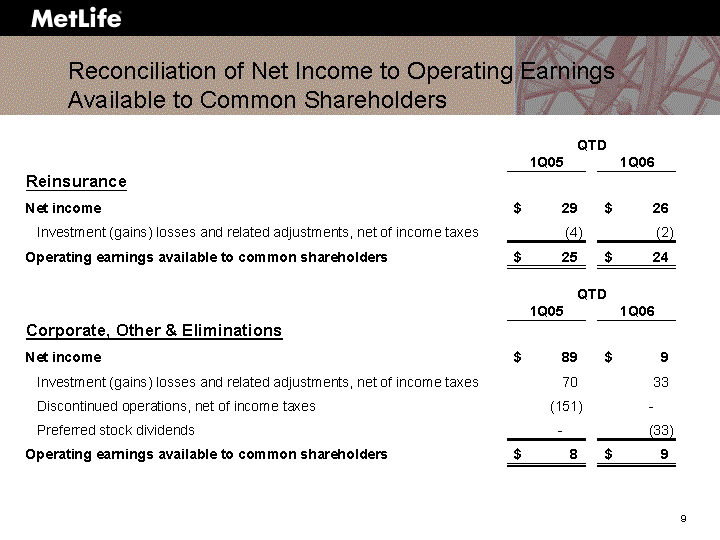
| Reconciliation of Net Income to Operating Earnings Available to Common Shareholders Available to Common Shareholders Available to Common Shareholders |
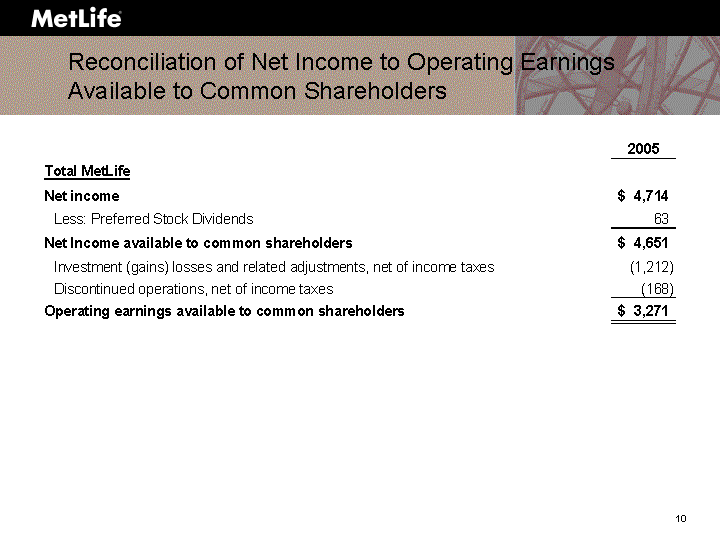
| Reconciliation of Net Income to Operating Earnings Available to Common Shareholders Available to Common Shareholders Available to Common Shareholders |
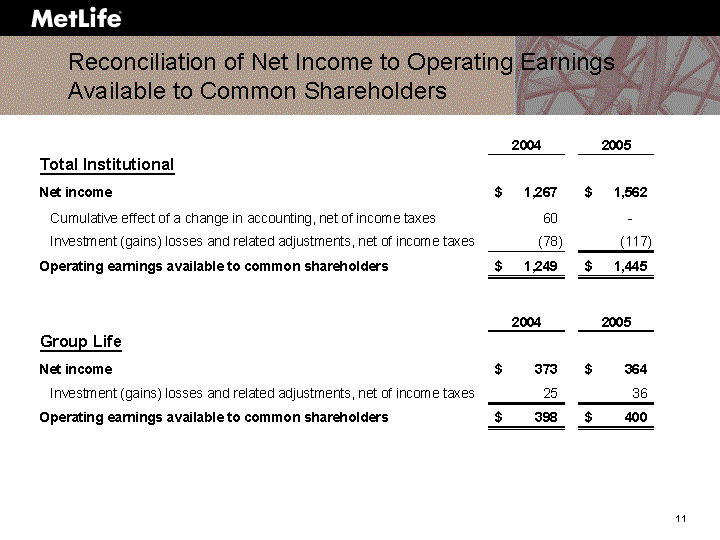
| Reconciliation of Net Income to Operating Earnings Available to Common Shareholders Available to Common Shareholders Available to Common Shareholders |
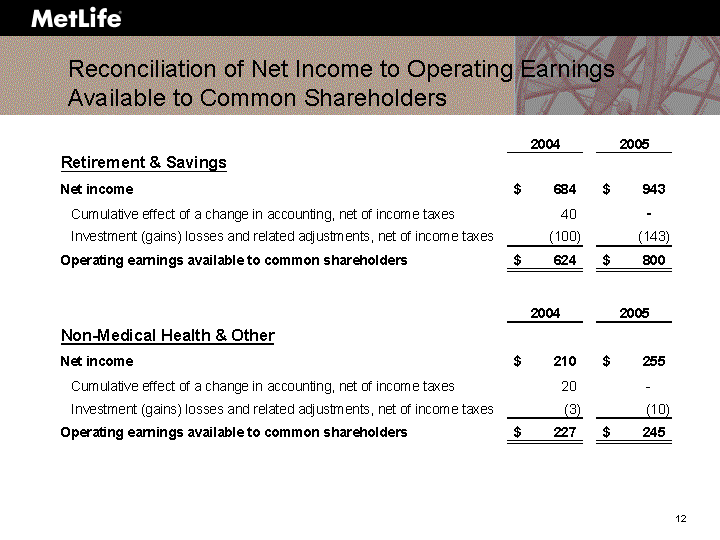
| Reconciliation of Net Income to Operating Earnings Available to Common Shareholders Available to Common Shareholders Available to Common Shareholders |